- Certificates of Competence

RYA Yachtmaster Coastal Exam
Full details of the exam syllabus and requirements are shown in the RYA Yachtmaster Scheme and Logbook (G158) available from the RYA webshop.
RYA Yachtmaster Coastal practical exams can be taken under sail or power and your certificate will be endorsed accordingly. You or a training centre provide the boat and the RYA provides an examiner. Note: All qualifying sea time and passages must be gained on vessels appropriate to the type of exam i.e. gained in sailing vessels for a sail exam and power vessels for a power exam.
The exam will include an assessment of your skippering skills, boat handling, general seamanship, navigation, safety awareness and knowledge of the IRPCS (collision regulations), meteorology and signals. You will be set tasks to demonstrate your ability and may also be asked questions on any part of the syllabus for all practical and shorebased courses up to RYA Yachtmaster Coastal level.
RYA Yachtmaster Coastal exam pre-requisites
Boats used for exams.
You may use your own boat or a boat that you have chartered or borrowed. You will be responsible for ensuring the boat is seaworthy and suitable for the area in which the exam takes place and equipped as shown below.
The boat used must be between 7m and 18m LOA and be in sound, seaworthy condition, equipped to the standard set out in the RYA book Cruising Yacht Safety (code C8). The boat must be equipped with a full up to date set of charts and navigational publications and be efficiently crewed, as the examiner will not take part in the management of the boat during the exam.
Before you book your exam please check that you:
- can provide a boat (either your own or a training centre's boat)
- have completed the required mileage and experience as skipper
- hold an SRC (Short Range Certificate) or higher level GMDSS radio operators qualification
- hold a valid first aid certificate
- have read the syllabus in the RYA Logbook (code G158)
- have read and comply with the pre-requisites above.
Additionally if not on the boat, you will need to bring to the exam:
- laminated or waterproof charts
- GPS set (may be hand held)
- tide tables
- pilotage information for the local area, eg pilot books, port information etc
- plotting instruments.
- Photographic ID card or document, such as a passport or driving licence
If you need your Certificate of Competence in order to work on board a commercial craft subject the MCA's codes of practice, you will need to get it commercially endorsed .
Useful links
Arranging your exam, commercial endorsements, exam payments service, mca manning requirements, professional qualifications.
- Yachtmaster Coastal (Power or Sail)
- Recreational

Yachtmaster Coastal Training
The IYT Worldwide Yachtmaster Coastal certificate is a recreational certificate of competency for command of sailing and/or power vessels up to 24 metres in length up to 60 nm offshore. It is a comprehensive live aboard course consisting of six days for sail or five days for power, which includes the practical on water examination. The minimum age to obtain this certification is 18. Candidates must either hold a recognised VHF Radio Operators Certificate or must take the full IYT VHF-SRC Marine Communications course and school must place order for this certificate while placing order for the Yachtmaster Coastal Certificate of Competency. If ordering VHF at the same time as Yachtmaster Coastal Certificate please upload a note to this effect. We have provided a sample note to upload when placing order. * Please note that we do not accept ISSA VHF qualifications. (I f you are unsure if your radio license will be accepted, please send a scanned copy of the front and back of your license to [email protected] . We will verify that your license is sufficient to receive the IYT Yachtmaster Coastal license).
It has come to our attention that it has not been made perfectly clear to all IYT Worldwide yachtmaster candidates that this certification is for recreational use only and may never be upgraded to a professional certificate. Therefore, we require all candidates taking a recreational IYT Worldwide Yachtmaster Coastal, Offshore or Ocean course to complete an acknowledgement prior to taking the course.
IYT’s Yachtmaster Coastal Sail Certificate covers command of a sailing vessel with a sail area of greater than 80 square metres/861 square feet. Please see the official statement here .
Course Outline
- International collision regulations
- Navigational charts and publications
- Dead reckoning and estimated position
- Position fixing
- Tides and currents
- Safety at sea
- Meteorology
- Boat handling
- Passage planning
Certificate Limitations
- Command of a vessel up to a maximum length of 78 ft /24 metres
- In coastal waters up to 60 miles offshore
- In moderate wind and sea conditions
- Not for commercial use
Note: Yachtmaster Coastal is a recreational course that can be taught in any language BUT cannot be upgraded to the professional Master of Yachts certificate.
What are the minimum entry requirements to apply for the IYT Yachtmaster Coastal course?
- 25 days and 800 miles at sea including 2 days as watch leader/skipper
- 12 hours underway on watch at night
- Minimum sea time must have been met prior to the final examination
What Does The Exam Consist Of?
The examination is an oral and practical test onboard a yacht plus a written theory exam. Candidates must demonstrate that they have sufficient ability to handle, dock, and anchor the boat with a required level of confidence. Candidates can expect to be examined on any subject contained within the syllabus and to be questioned on any of their yachting experience to date.
In the event that the examiner considers an examinee not to have achieved the required standards, a certificate will not be issued. In this case, a confidential report will be sent to the candidate outlining the reason or reasons for failure and suggesting remedial action that could lead to the successful completion of the course. Completion of the IYT Worldwide Yachtmaster Coastal course is not a guarantee of passing the examination and receiving your certificate.
How Do I Apply For Enrollment?
Candidates may apply to any of the participating IYT Worldwide Partner Schools worldwide who offer this course.
In order to apply for the IYT Worldwide Yachtmaster certification courses, a detailed yachting resume must be sent to your IYT training school for evaluation.
As you advance and become more proficient as crew or skipper you take on bigger challenges that require proper training to ensure the safety of your family and friends. The bigger the boat or length of adventure the more training you require.
Most of us prefer to spend our time on the water and not in a classroom. To facilitate this, IYT has a series of E-learning courses available for the theoretical part of sail and powerboat training.
- Take one of our online (Elearning) courses for your next level of training.
- Plan your practical training at one of our many schools worldwide to earn your final qualification.
- Book in advance with your school as class sizes and availability may be limited.
- Review the IYT course progression details to learn about professional level courses.
- Spend time on the water and properly log your seatime.
The Boating Lifestyle is one of the most rewarding pursuits available. There is something physically and emotionally invigorating when you are offshore. To enjoy the experience fully you need the proper training & skills to be safe, prepared and command a vessel.
Recreational Student Information
Benefits of an iyt certification.
IYT is the largest provider of crew and skipper certificates for the recreational yachting industry in the world. Learn more about the benefits of an IYT Certificate.
Certificate Renewal
For many IYT certificates, there is the need to re-qualify for your certificate every 3 to 5 years. This ensures that our certifications are meeting international standards.
IYT Yachting Passport
The IYT Passport is recognized in over 40 countries around the world and offers you an opportunity to study and train worldwide.
- Course Progression
A beginner at sailing or operating a powerboat should be familiar with the training path that is available from IYT. Many recreational boaters progress to become crew on superyachts.
- Privacy Policy & Terms Of Use
- Become a Partner School
- Register with IYT
- Find a School
- IYT E-Learning
- Certificate Renewal & Replacement
- Get Certified
- Recreational Training Course Progression
- IYT Passport
- Crossover Opportunities
- Course Progression Interior
- Dive Boat Training
- Forms And Docs
- Instructor Training
- Personal Watercraft Operator
- Dinghy Sailing Programme
- IYT Try Sailing
- IYT Introductory Sailing Skills
- IYT Day Skipper / Crew Sail
- International Crew
- International Flotilla Skipper
- International Bareboat Skipper
- International Flotilla Skipper Sail – Catamaran
- International Bareboat Skipper Sail – Catamaran
- International Certificate of Competency (ICC Certificate)
- Powerboat Skipper
- Yachtmaster Coastal Sail – Catamaran
- Yachtmaster Offshore (Power or Sail)
- Yachtmaster Offshore Sail – Catamaran
- Yachtmaster Ocean
- Patron de Yates (Yachtmaster Coastal Spanish edition)
- Marine Communications (VHF-SRC)
- Small Powerboat and Rib Master (MCA Recognised)
- IYT Commercial Tender License Course
- Weather Master
- Navigation Master
- Master of Yachts Coastal/Mate 200 Tons (Power or Sail)
- Master of Yachts Limited (Power or Sail)
- Master of Yachts Unlimited
- Superyacht Chef
- Superyacht Deck Crew Course
- Superyacht Hospitality Training
- Boat Engineer Course (SCV Code for Vessels Operating in the Caribbean)
- IYT-MSWI BoatMaster Course
- Become An IYT School
- Upgrade Your School
- Find A School
- Course Levels
- Instructor Qualifications
- Vessel Requirements
- Vessel and Facility Requirements
- Unauthorised Schools and Other Entities
- Shipping & Delivery
- Government Approvals

RYA Yachtmaster Offshore / Yachtmaster Coastal / Master of Yachts 200 Course 300
MPT is the most complete full service private maritime school in the country and has been training mariners since 1983. Our Fort Lauderdale based campuses host over 45,000 square feet of classrooms, deck and engineering training labs, the Ship's Store, and student service facilities.
Preparing for RYA Yachtmaster Offshore / Yachtmaster Coastal / Master...
Course description.
Yachtmaster Certificate of Competency
The Yachtmaster Qualification is the pinnacle of the RYA (Royal Yachting Association) Training and Certification System. It is widely recognized throughout the world as a prestigious accomplishment.
Holding this credential can:
- Improve your resume for any deck department position on yachts - Serve as prerequisite training for an MCA OOW 3000 GT CoC - Professional Development in your yachting career - Serve as your Certificate of Competence (CoC) for operators of yachts up to 200 tons
The Yachtmaster Course should be undertaken by crew aspiring to advance to the MCA OOW level up to 3000 tons and by those who are advancing to the command level for Master of Yachts up to 200 tons.
2 Routes Available – Same Course:
Yachtmaster Coastal Yachtmaster Offshore
Yachting professional candidates are encouraged to start their training and professional development as early in their career as possible. Many will take their STCW Basic Safety Training Program (#140) and then when they qualify, it is recommended to obtain the Yachtmaster Coastal CoC. Candidates wishing to upgrade to the offshore route later can simply examine, without additional required training.
Whether you qualify for the Yachtmaster Coastal or Offshore, the training is the same. The only difference is your experience and practical skill level. You will be examined towards whichever level you qualify for.
The MPT Yachtmaster Coastal and Offshore Course (#300) is taught on a Motor Yacht and the practical training and examination are towards a Motor Certificate of Competence. (If you are applying for a Sail Endorsement, this course will not satisfy your practical training and exam requirements). All sea time must be on a power boat and not on a sail boat under power. The Theory, SRC, PPR, and Basic Training courses are the same for both schemes.
The MPT Yachtmaster advanced level certification is available in a 2 week + exam program combining shore-based theory and practical hands-on techniques for a Motor Vessel and the RYA Practical Examination. The first week of class is in the classroom (theory) and the second week is Practical, out on the boat. In addition, there will be class on Saturday of the first week so please plan accordingly.
YACHTMASTER COASTAL & OFFSHORE Subjects Include:
One week (40 hours) of comprehensive shore-based theory module with written assessment papers including navigation, tidal calculations, international and inland rules of the road, coastal pilotage, meteorology, anchoring and mooring, docking and undocking, buoyage systems, safety, voyage and passage planning, general ship knowledge and seamanship. A theory examination will be conducted after the completion of the 40-hour theory portion of the program.
One week of Yachtmaster Offshore/Coastal practical training is conducted on board one of MPT’s Yachts. These yachts are up to 48’ and are twin screw motor yachts. This part of the instruction covers seamanship skills such as nautical terms, tides, marlinespike seamanship, anchor work, boat handling, docking, general yachting skills, basic weather, navigation and passage planning. This course will be a preparation course for your final Yachtmaster Coastal/Offshore Examination. The practical portion of the course will be conducted during daytime, evening and occasionally may include weekend hours.
The Yachtmaster Course #300 is an Advanced Review Course and it is assumed that candidates will have the prerequisite knowledge of the Basics of Navigation and recommended to the level of RYA Day Skipper, and the very least, the level of the Essential Navigation On-line course. To increase your likelihood of success, we recommend taking the online pre-course - ESSENTIAL NAVIGATION. Additionally, flash cards are available in the MPT Ship's Store for rules study in lights and shapes. Also, many Apps are available to assist in these subjects for pre-study. It is also strongly advised that you pick up your study material well in advance of the start of your course. Pre-study is essential for a successful outcome of this course.
The RYA Yachtmaster course is accredited by the RYA and MCA and recognized for service as Captain or Mate (OOW) up to 200gt up to 150 miles from a safe haven, at the Offshore level or up to 60 miles from safe haven at the Coastal level.
The Yachtmaster CoC meets the STCW A-V1/1 and section A V1/1-4 when combined with Basic Training Courses. Yachtmaster Offshore fulfills the prerequisite for MCA OOW 500 and 3000 GT and the MCA STCW A-II/2 Command Certificate for Master 200GT.
Sea Service Prerequisites (minimums): Note you must be able to provide proof of your sea service before undertaking the exam. This should be provided at least 2 weeks before the course when possible to allow our team to review it and ensure your eligibility for the course. Speak to your MPT Career Counselor or your instructor for assistance.
Sea Service can be proven by submitting one or more of the following:
- Log book (RYA or other acceptable)
- Sea Service Testimonial Letters from captains, owners or operators of vessels outlining vessel specifics, time underway, your capacity served onboard and the location of the service (tidal or non-tidal waters, etc).
- Sea Service Forms (calendar style - provided you can supply all of the additional information such as number of miles, etc.) Method 2 is preferred.
Yachtmaster Coastal: Motor - Option 1
Without RYA Coastal Skipper Practical certificate:
- 2 days as skipper on vessels of less than 24 meters
Note: No more than half of the required miles can be on vessels over 24 meters
Yachmaster Coastal: Motor – Option 2 A & B
With RYA Coastal Skipper Practical Certificate:
Can be used to enter OOW 3000GT program and modules
A. Mariners with Coastal Skipper Practical Certificate and with more than half of required sea service on vessels less than 24 meters
- 20 days on board
- 2 days as skipper on vessel less than 24 meters
B. Mariners with Coastal Skipper Practical Certificate and with more than half of required sea service on vessels greater than 24 meters
- 30 days on board
Yachtmaster Offshore: Motor
- 50 days sea time overall on motor vessels
- 5 days in the command position on the vessel (as Master)
- 2500 nautical miles logged with half transiting through tidal waters and half on a vessel of less than 24 meters that is not a tender.
- 5 passages over 60 nautical miles, including 2 overnight and 2 in command (as Master) of vessel.
Yachtmaster Ocean:
- Obtain Yeachmaster Offshore
- Complete the RYA astro/ocean shorebased theory #306
- Ocean passage of 600 nautical miles or more as captain or mate
- Complete oral exam with RYA examiner successfully
For Commercial Endorsement:
In addition to the SRC and First Aid (must have been taken within 5 years) you will need to obtain an MCA Certificate of Medical Fitness (ENG-1) as well as the Personal Survival Training (4 Modules of STCW 210) and the online Professional Practices & Responsibilities (PPR) Certificate. If you are planning to work commercially, you should simply add the STCW Basic Training Program, which will include the approved Personal Survival and First Aid automatically and will also allow your Yachtmaster CoC to have the STCW endorsement as well. Most boats internationally require this of all crew working commercially. We also recommend the Security Awareness or Designated Security (VPDSD) Course if you are working commercially as well. These are all separate fees from the Yachtmaster Course however MPT offers Package discounts, speak to an MPT RYA Specialist for more information and assistance. There is also a fee candidates will pay to the RYA for the commercial endorsement.
Written & Practical Exam Information:
The written exams are administered at MPT at the end of the shore-based theory segment of your program. They include all of the topics covered in the course. All of the shore-based courses and experience criteria must be fulfilled before the RYA Examiner will conduct the practical assessment. The final exam will be conducted by an independent and unbiased RYA Yachtmaster examiner and takes the form of an extensive oral and practical examination on a motor yacht. Candidates who have taken MPT's Yachtmaster course may use one of the MPT vessels for the exam at no additional fee. The practical exam will take an additional one-two day and is scheduled when the examiner is available and generally immediately after the course, weather permitting. Once your eligibility has been reviewed (sea time and prerequisites met), the schedule for the practical examination is predicated on several things:
1)The weather as this is a practical underway examination 2)The availability of the RYA Examiner (this is not an MPT employee)
Examinations may need to be scheduled for additional days which may not be consecutive to the dates of the course.
Exam Subjects:
We will review with you the knowledge-based subjects during your shore-based theory week and also fine tune your boat handling skills during your practical course, but you should be familiar with the following areas when you join the class and proficient by the exam date. (Note if you are not already well versed in these subjects when you arrive, you are strongly encouraged to take the Essential Navigation (online course) as there is not sufficient time to cover the basics in the 2-week program. Ask about #333)
- Knowledge of the International and Inland Rules of the Road.
- Safety. The candidate will be expected to know what safety equipment should be carried on board a yacht.
- Boat Handling, Maneuvering, Docking: Yachtmaster Coastal students will be expected to answer questions & demonstrate ability in simple situations only. Yachtmaster Offshore candidates are expected to demonstrate ability in more complex situations and will also be expected to show a higher level of expertise.
- General seamanship, including maintenance.
- Responsibilities of the skipper
- Navigation, Basic Weather
- Radio Communication & Signaling
- Command presence, management and direction of crew.
- Essential Navigation (online course)
Practical Exam Fees:
The RYA Examination Fee for the initial examination will be paid by MPT as part of your course tuition. Additional RYA fees are paid by candidate if a subsequent examination is needed.
If at the end of your course you wish to postpone the practical exam date, you are permitted to return for exam and RYA exam fee paid by MPT, within one calendar year, space permitting.
Additional Recommended or Required Courses:
- Essentials of Navigation (Online Pre-Course) #333
- First Aid & CPR #143 or Take STCW Basic Safety Training #141, 142, 143, 144
- SRC VHF Radio License #303 Required (offered Online) or GMDSS GOC #404
- RYA PPR (Professional Practices & Responsibility) #335 ONLINE COURSE
- MCA Approved Engine Course #440
- USCG Radar Course #148 & ARPA Course #150 or MCA Nav/Radar/ARPA Course #402
If you have three years of yacht service, speak to a career counselor about continuing straight through your OOW or Chief Mate 3000 GT program.
Required Materials
RECOMMEND PRE-STUDY: Essential Navigation online, course #333, COLREGS Study Apps or flashcard, and course notes. AVAILABLE IN MPT SHIPS STORE or bring with you the following: Pencil (mechanical or #2) Paper Chart Eraser (We recommend white- like magic rub or Staedtler), Navigation Tools (parallel rules/Portland plotter/triangles – your choice), Dividers (we recommend two- one as divider and one as compass), Calculator (we recommend the TI-30x), Hand Bearing Compass - optional though recommended (We recommend Weems & Plath #2004). Pick up at MPT when you register or when you check-in: Yachtmaster Shore based Training Manuals & Charts (provided by MPT).
11 day class in Fort Lauderdale
RECOMMENDED PRE-STUDY: Available at MPT Ships Store Complete Course Training DVD Flashcards AVAILABLE IN MPT SHIPS STORE OR BRING WITH YOU: Pencil (mechanical or #2) Paper Chart Eraser (We recommend white - like magic rub or staedtler) Navigation Tools (parallel rules/Portland plotter/triangles - your choice) Dividers (we recommend two - one as divider and one as compass) Calculator (we recommend the TI-30x) Hand Bearing Compass (We recommend Weems & Plath #2004) PICK UP AT SCHOOL WHEN YOU REGISTER OR WHEN YOU CHECK-IN: Yachtmaster Shorebased Training Manuals & Charts (provided by MPT)
Course Photos

Testimonials
Not suggestions. Thanks for letting me be your student! Alejandro, Friday August 2015 RYA Yachtmaster Offshore / Yachtmaster Coastal / Master of Yachts 200
A bit more time would be nice! But Steve was an awesome instructor.Very easy to follow and very thorough. Arthur, Wednesday November 2013 RYA Yachtmaster Offshore / Yachtmaster Coastal / Master of Yachts 200
1915 South Andrews Avenue, Fort Lauderdale, FL 33316, +1-954-525-1014 | +1-888-839-5025 (Toll Free)
Site map | privacy notice | cookie policy | accessibility notice, 1915 south andrews avenue, fort lauderdale, fl 33316 +1-954-525-1014 +1-888-839-5025 (toll free).
RYA Certificates of Competence, Part 2 - Yachtmaster Coastal
Sailing qualification recognised around the world as a clear mark of your sailing ability.
By Marcin Wojtyczka
In this article in series about RYA certifications we reveal how to pass the RYA Yachtmaster® Coastal Certificate of Competence.
The RYA Yachtmaster Coastal Certificate of Competence is proof that you have the knowledge needed to skipper a yacht on any coastal cruise.
The holder of a Yachtmaster Coastal qualification should be competent to skipper a yacht of up to 24 metres LOA (up to 200gt) in waters up to 20 miles from a safe haven.
Don’t treat the examination just as an exam. This is a great opportunity to get feedback on your skills and become a better sailor.
Requirements
You can find the official requirements here .
To pass the exam you need ample experience and be able to navigate as well as handle the boat at sea in sight of land. You can take the exam without holding previous certifications from the ladder (e.g. daily or coastal skipper) or doing any course before as long as you have enough knowledge and experience.
Prior to the Yachtmaster Coastal examination, you must have a minimum of 30 days at sea, with 2 days as a skipper and at least 800 miles logged, including 12 night hours. If you hold the Coastal Skipper course certificate already then this is reduced to 20 days at sea with 2 days as skipper, 400 miles logged and 12 night hours. Half the qualifying sea time must be conducted in tidal waters. You will also need to hold a GMDSS short-range radio certificate.
Preparation
Before taking the practical exam at sea, it is recommended to take Yachtmaster Offshore Theory course especially if you have not sat at the chart table for a while. Holding the RYA Yachtmaster Theory is also required if your long-term goal is to become the Officer of the Watch 3000GT.
You should also consider taking a practical preparation course. There is no official RYA prep course, but many sailing schools offer on-the-water preparation courses. Our trips are focused on training based on the RYA syllabus and can get you prepared for the exam as well. We can evaluate whether you are at the right level to pass the exam and identify gaps in your knowledge. Many of our participants passed the prestigious RYA Yachtmaster Coastal exam and keep returning year after year to us in order to become yet more confident and experienced. Our practical on-the-water training builds confidence, teaching you everything from basic terminology and safety tips to how to skipper a yacht and manage its crew.
Exam Syllabus
This is a broad description of the topics that will be covered during the practical exam. You are supposed to demonstrate knowledge of competence in many areas listed below. In each section, the examiner will expect to see that you can take full responsibility for the management of the yacht and crew.
1. Convention on the International Regulations for Preventing Collisions at Sea (COLREGs)
Questions will be covering the International Regulations. You must be aware of the existence of Local Regulations, but they will not be expected to memorise specific local regulations.
- General rules (1-3)
- Steering and Rules of the Road (4-19)
- Lights and shapes (20-31)
- Sound and light signals (32-37)
- Signals for vessels fishing in close proximity (Annex II)
- Distress signals (Annex IV)
You will be expected to deliver a safety briefing and know what safety equipment should be carried on board a yacht, based either on the recommendations in the RYA Boat Safety Handbook (C8) , the ISAF Special Regulations or the Codes of Practice for the safety of Small Commercial Vessels MGN 280 (M) . It should cover the following areas including the responsibilities of a skipper:
- Safety briefing
- Life jackets
- Safety harnesses
- Lifejackets
- Distress signalling (flares and electronic means)
- Fire prevention and fighting
- Boat stability
- Knowledge of rescue and emergency procedures
- Helicopter rescue
3. Boat Handling
You will be expected to answer questions or demonstrate ability in simple situations only. Topics can include:
- Coming to and weighing anchor under power in various conditions of wind and tide
- Simple berthing and unberthing situations in various conditions of wind and tide
- Recovery of man overboard and being able to describe the effects of cold-water shock and the aftercare requirements of a casualty who has been in the water
- Boat handling in confined areas under sail
- Boat handling in heavy weather
- Helmsmanship and sail trim to sail to the best advantage (point of sails)
- Use of warps for securing in an alongside berth and for shifting berth or winding
4. General Seamanship, including maintenance
- Properties, use and care of synthetic-fibre lines
- General deck work at sea and in the harbour
- Engine operations and routine checks and troubleshooting
- Improvisation of jury rigs following gear failure
5. Responsibilities of skipper
- Can skipper a yacht safely and manage the crew
- Communication with crew
- Delegation of responsibility and watch-keeping organisation
- Preparing yacht for sea and for adverse weather
- Tactics for heavy weather and restricted visibility
- Emergency and distress situations
- Victualling for a cruise and nutrition at sea
- Customs procedures
- Standards of behaviour and courtesy
6. Navigation
- Charts, navigational publications and sources of navigational information
- Chartwork including position fixing and shaping course to allow for tidal stream and leeway
- Tide and tidal stream calculations for standard and secondary ports
- Buoyage and visual aids for navigation
- Instruments including compasses, logs, echo sounders, radio navaids and chartwork instruments
- Passage planning and navigational tactics
- Pilotage techniques
- Keeping navigational records
- Limits of navigational accuracy and margins of safety
- Lee shore dangers
- Use of electronic navigation aids for passage planning and passage navigation
- Use of waypoints and electronic routeing
- Position fixing with and without the use of GPS
- Course to steer and estimated position
- Coming in and out of the harbour during the day and/or night
- Knowledge of Radar and how to use it for collision avoidance and restricted visibility
- General understanding of AIS for restricted visibility
7. Meteorology
- Definition of terms
- Sources of weather forecasts
- Weather systems (frontal depressions and highs in the Northern and Southern Hemisphere)
- Local weather effects (sea breeze, fog, wind funnel effect)
- Interpretation of weather forecasts and synoptic charts, barometric trends and visible phenomena
- Ability to make passage planning decisions based on forecast information
You must hold the SRC Certificate of Competence (VHF) in radiotelephony or a higher grade of certificate in radiotelephony
Learning materials
- Insightful blog series on the Yachtmaster exams from the perspective of RYA examinator.
- The Complete Yachtmaster - Bestseller since first publication that has established itself as the standard reference for Yachtmaster students as well as skippers of all levels of experience.
- RYA Yachtmaster Shorebased Notes - Highly illustrated book on all aspects of the RYA Yachtmaster syllabus.
- The RYA Navigation Exercises - This is one of the best books about navigation. It accompanies all RYA training courses and includes two training charts (RYA Training Charts 3 & 4).
- RYA Certificates of Competence
- Certificates
Join our newsletter to get the news about new routes
- Certificates of Competence
- RYA Yachtmaster
What is an RYA Yachtmaster?
The RYA Yachtmaster® Certificate of Competence is often the ultimate aim of aspiring skippers. It is a well known, highly respected qualification worldwide, proving your experience and competence as a skipper. Unlike other qualifications in the cruising programme, there is no formal training course to become an RYA Yachtmaster. Instead, provided you have sufficient experience, certification and seatime, you can put yourself forward for an exam to test your skills and knowledge. There are a number of RYA navigation courses that will help you prepare for your exam. Many RYA Yachtmaster candidates also choose to book themselves into an RYA training centre for some specialised exam preparation training, but this is not compulsory.
You are capable of coastal passages
You are competent to undertake passages up to 150 miles offshore
You have the knowledge and experience to sail worldwide
- Arranging your exam
The Coastal and Offshore exams are practical tests afloat, and the Ocean is an oral exam. Find out more about qualifying passages, exam fees and how to book.
With an RYA Yachtmaster Coastal, Offshore or Ocean Certificate of Competence you can start a career at sea.
You'll need to have the appropriate qualification for the vessel and area of operation.
If you want to work commercially, you'll need a commercial endorsement.
Find out more about other RYA professional qualifications.
- Getting the most from a Yachtmaster Fast Track course
Can you really become an RYA Yachtmaster in as little as 14 weeks? Check out our top tips for getting the most from a Yachtmaster Fast Track course...
- Skip to primary navigation
- Skip to main content
- Skip to footer

(866) 300-5984 [email protected]
IYT Yacht Master Coastal -Power or Sail
- Format 6 Days
Course Description
The IYT Worldwide Yachtmaster Coastal certificate is a recreational certificate of competency for command of sailing and/or power vessels up to 24 metres in length up to 60 nm offshore. It is a comprehensive live aboard course consisting of six days for sail or five days for power, which includes the practical on water examination. The minimum age is 18.
It has come to our attention that it has not been made perfectly clear to all IYT Worldwide yachtmaster candidates that this certification is for recreational use only and may never be upgraded to a professional certificate. Therefore, we require all candidates taking a recreational IYT Worldwide Yachtmaster Coastal, Offshore or Ocean course to complete an acknowledgement prior to taking the course. IYT’s Yachtmaster Coastal Sail Certificate covers command of a sailing vessel with a sail area of greater than 80 square metres/861 square feet.
Training Certificate of Completion
Candidates completing this course can be awarded the IYT "Yacht Master Coastal - Power or Sail" Certificate of Competency.
Available Dates
Call to schedule
- Cookie Policy
- Privacy Policy
- Terms of Use
Sign Up For Our E-Newsletter!
Maritime Institute Online Course Portal Book Examination - Everett, WA Book Examination - San Diego, CA
Privacy Overview
Log in to maritime institute.
Yachting Monthly
- Digital edition

How to pass your Yachtmaster exam
- Chris Beeson
- September 16, 2015
The global standard of sailing qualifications is achievable for any experienced, competent skipper. Tom Cunliffe explains how to pass your Yachtmaster exam
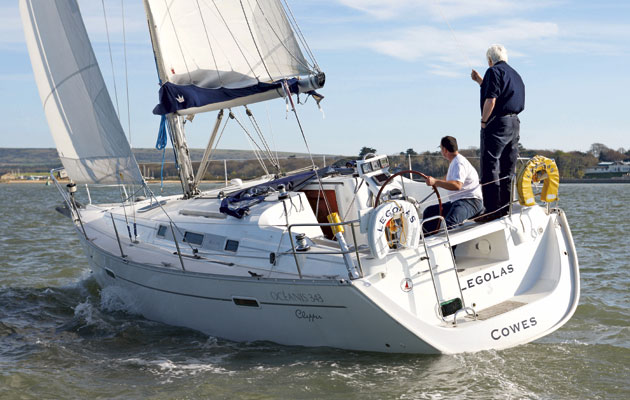
The only certificates accepted by the authorities are those issued after an at-sea examination. To become a fully-fledged Yachtmaster, the practical test is the only one that counts Credit: Graham Snook/YM

Tom Cunliffe is an RYA Yachtmaster examiner. He has passed and failed hundreds of Yachtmaster candidates over the years
We in the UK are exceedingly fortunate. Just as the English language is the best bet for a world traveller, our very own RYA/MCA Yachtmaster qualification happens to be the global standard for sailing. It’s required for anyone planning to become a professional and, thanks to the continuing efforts of the RYA, Brits who sail for leisure still don’t have to carry any proof of competence in home waters. Despite this blessed lack of regulation, the Yachtmaster certificate remains the logical target of many a self-motivated sailor. It also represents the icing on the cake for those looking for the reassurance of an external assessment.
Courses and exams
Yachtmaster training can take place on a boat or in a classroom. A shore-based course, either at desks in a school or via the increasingly popular Internet distance learning programmes, ends with a Yachtmaster theory exam. Success in this will help a student in subsequent qualification upgrades, but it is not officially recognised. The only certificates accepted by the authorities are those issued after an at-sea examination – the Yachtmaster Practical . To become a fully-fledged Yachtmaster, this practical test is the one that really counts.
Yachtmaster Prep

Meteorology matters: a favourite with examiners is to produce a weather map and invite you to analyse it. Be ready and know your subject
This is a non-RYA course and, as such, has no official status or syllabus. However, it is run successfully by many RYA sailing schools to prepare candidates for an examination which generally follows on at the end. Up to four students spend several days together on the boat in which they will be examined. The benefits are that they get to know one another and their yacht under the guidance of a highly qualified Yachtmaster Instructor. The general feeling is that these tutors can’t teach you much you don’t already know in a week, but that they are very good at coaching the best out of those skills you already have. Prep courses are great for brushing up on how to jump through the various hoops an examiner may set up. What they can’t do is make someone who doesn’t have suitably constructive mileage into the confident skipper examiners are looking for.
Coastal or Offshore – what’s my level?
Recently, the old Coastal Skipper ticket has been superseded by the new ‘Yachtmaster Coastal’ certificate. The qualifying mileage for this MCA-recognised qualification is 800, with passage and night-hour requirements being relaxed in comparison with ‘Yachtmaster Offshore’, which keeps its 2,500-mile entry level. Either is a proper Yachtmaster qualification and can be described as such. Only the often-dropped suffix distinguishes the two. The syllabi are identical, the variant is the rigour of the examination. Apply for ‘coastal’ and the examiner, recognising that you have less sea-time, will be more inclined to cut you a bit of slack.
The RYA has noted that most candidates are really only making ‘coastal-status’ passages. In real terms, this includes an annual trip across the Irish Sea, the North Sea or the Channel in a calculated weather window, which is very different from setting off from Ramsgate towards Norway with five days and potentially serious conditions ahead of you. The implications should be clear: unless you need the Offshore ticket for professional reasons, if in doubt, go for Coastal.
Preparing yourself and the boat
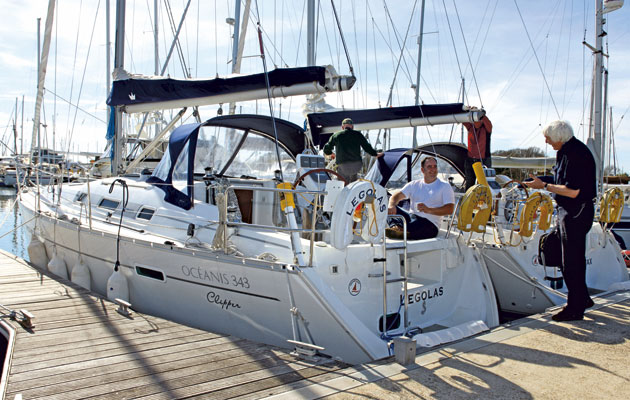
A relaxed candidate with a mug of tea makes a better impression than a harassed-looking one
If you’ve signed on with a sailing school, you’ll be stuck with the boat you’re given. You can be confident that this yacht ticks all the official boxes by being coded for commercial use, but while some are very up-together, others are not. If the boat is generally sloppy and scruffy, you can at least make an effort to stow the mainsheet in a seamanlike manner while you are nominally skipper.

Neatly coiled lines reflect well on the skipper
You can also ensure that fenders are hung at the same level, sharpen up the guardrails and see that things generally look as though somebody knows the difference and cares. Then the examiner won’t hold the ratty lifebuoys and the smelly bilge against you.

Mind that your dress and demeanour don’t make a bad first impression
Try to be ready in good time so that you aren’t involved in a last-minute kerfuffle. If you’re relaxing in the cockpit with a mug of tea when the examiner arrives, he or she will be more impressed than if you’re frantically working out tidal heights and scuffling through the chart table. Wear sensible kit. Don’t worry if it’s not this season’s fashion. My examiner turned up in an old duffel coat back in 1978 and I think I was wearing a canvas smock and a flat cap, but the smock was freshly laundered and the cap was right way round…
The main thing is that you can sail, but an examiner is always pleased to be freed of any hassle with the paperwork. Most of us are no better with admin than you are, so make our lives easy by producing an up-to-date first aid ticket and all the rest, plus a cheque made out to the RYA – not the examiner, perish the thought!
Passage planning

Your passage plan should be realistic. Keep it simple and be ready to adapt and update as things develop
You may be given the opportunity to produce a passage plan before the examiner arrives. If so, make it realistic. Don’t plot every course to the last degree. After all, you don’t know what speed you’ll make or what the wind will really do. Check tidal gates, distances, viable alternatives and the weather. Look at any hazards, sort out a time to leave and have a plan for updating as things develop. That’s about what you’d do if there were no exam, and that’s what I, at least, want to see.
Examination on your own boat
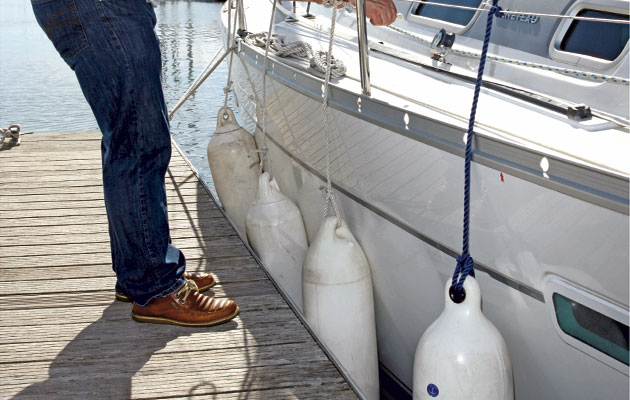
A nicely level line of fenders sends a good signal to the examiner
You don’t have to go to a sailing school to be a Yachtmaster. I love it when a candidate asks to be examined without training on his own boat. Don’t worry if she isn’t coded. There’s no legal requirement that she should be. Most of mine haven’t been either, and I couldn’t care less.
As an examiner, I want to see that your priorities are sound and that you’re thinking clearly and for yourself. On the day, the yacht must be clean, tidy and seamanlike. Waterline crisp, sail covers Bristol fashion, not looking like some poor bird with a broken wing, ropes carefully stowed, a comprehensive chart kit for the waters to be sailed, the makings of a meal plus snacks and, of course, everything that counts should be working.
What the examiner is looking for
Feeling relaxed in close quarters

Competent, confident boathandling counts well in your favour
If there’s one thing that will upset an examiner, it isn’t that you forgot to put on your lifejacket, it’s that he feels insecure when you begin manoeuvring in a marina. Take it from me, there’s nothing worse than sitting at the backstay wondering what you’re going to hit. If the boat slides sweetly out of her berth with everyone knowing what’s required and no shouting, then moves away easily with the examiner confident you’re in charge, that you’ve checked the next alleyway for collision risk, that your choice of speed is sensible and efficient and that it never enters his head to feel anxious, you’re well on the way to a pass after five minutes. No course can teach you this. It can only tick the box confirming you’ve managed it once or twice. The rest is up to you and your sea time.
Wind awareness
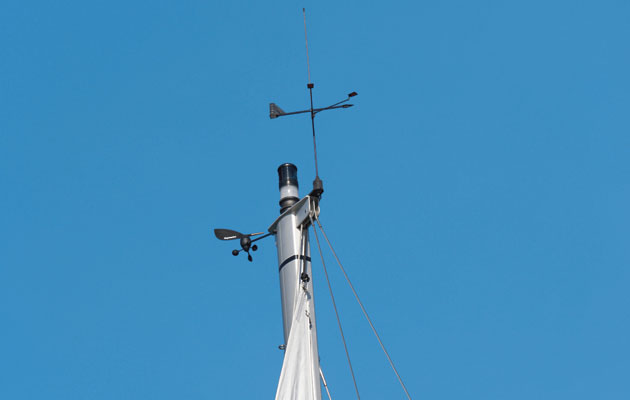
You should always be aware of the true wind direction and how it will influence any manoeuvres
Here’s another subject you can’t learn on a prep course. Knowing where the wind is and how it relates your position to any impending manoeuvres is critical. I often ask a candidate where the wind is coming from when he’s approaching a situation we both know will involve some sort of gyration under sail. If he looks instinctively at the masthead or, worse still, an instrument set to apparent wind, he’s dropped a bagful of points. At this stage, his mind should be setting up where the boat will best be placed to make her critical turns. Apparent wind isn’t going to help him much. What he should be doing is glancing at the water and noting the tiny ripples to assess what the true wind is actually doing. I’m often amazed at how many folk have never been shown how to do this. Racing sailors can handle it in their sleep, because they need to predict windshifts, but cruisers tend to get lazy, so make sure you can read the wind.
Good sailing
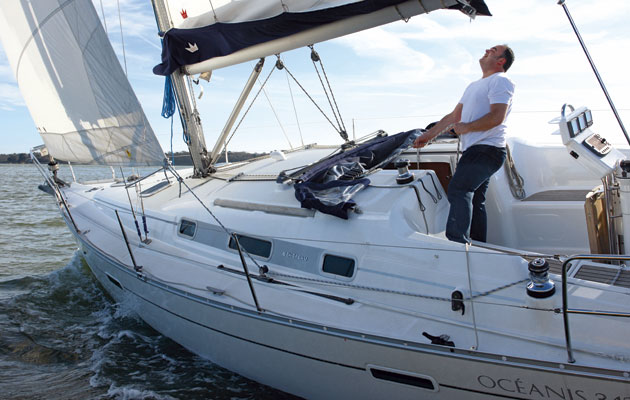
No need for incessant, race-style tweaking, but pay due attention to sail trim while the yacht is under way. If there’s a mainsheet traveller, use it
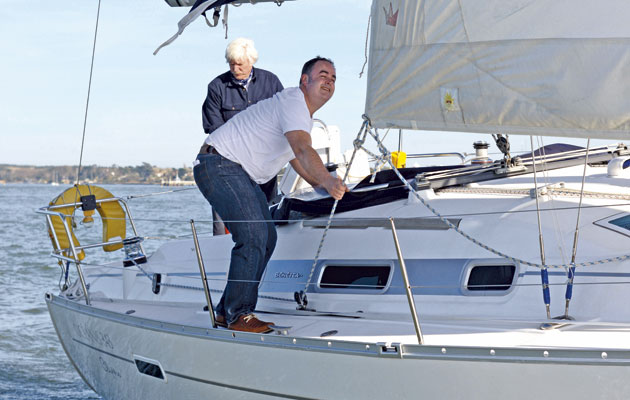
Ensure that the genoa sheet leads are properly positioned for the point of sail you’re on

Lovely: both mainsail and genoa set up with the right amounts of tension and twist
All examiners hate to see a yacht sloppily sailed on passage. Make sure that your crew are using the traveller, that genoa fairleads are properly positioned, that the main is well set up with kicker and mainsheet tension for twist. Above all, do not sail over-sheeted. It’s a dead giveaway that you just haven’t been out there enough yet.
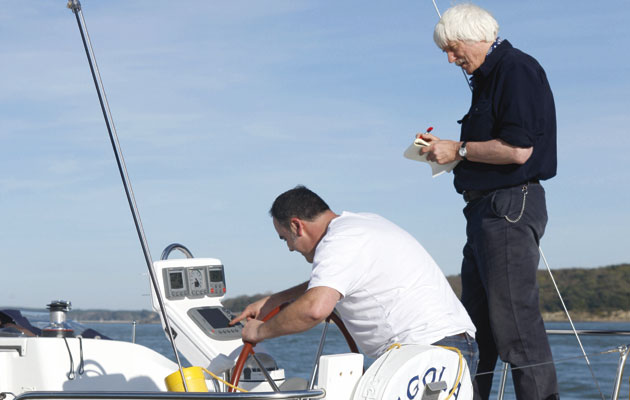
Too much staring at the plotter screen betrays nervousness
In the days before GPS set navigators free, people used to fail exams by what we called ‘sailing the chart table’ rather than skippering the yacht. Assuming the test to be all about some sort of imagined ‘correct navigational practice’, candidates nailed themselves to the navigatorium when they should have been up on deck directing operations and watching out for the ship coming up astern that was suddenly looking bigger every moment. Well, guess what? Nothing has changed. This remains a big problem with neophyte Yachtmasters.
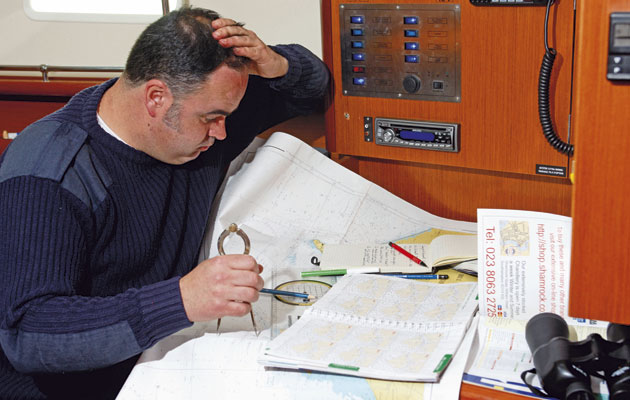
Sail the boat, not the chart table
The secret is to plan well, then nip below every so often on passage to keep an eye on what’s going on in the chart department and whizz back on deck pronto to carry on skippering the boat. I’ll lay a pound to a penny it’s what you do when there’s no examiner on board, so have the confidence to back your own usual practices. This is particularly important at night in crowded waters. An unsuccessful candidate often fails himself by allowing disorientation to creep in, simply by not keeping the true perspective on events, which can only be found on deck.
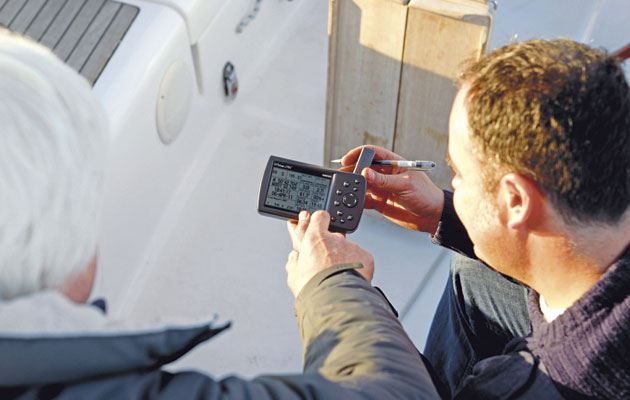
The use of electronic nav-aids such as GPS is not ‘cheating’ – it’s an integral part of navigation
All examiners have their own take on use of electronics. Personally, I want to know my candidate is making modern aids to navigation, including a chart plotter if there one, an integral part of his navigational policy. The idea, as one candidate suggested, that use of GPS is somehow ‘cheating’ is incomprehensible to me. I will almost certainly ask at some stage that the yacht be navigated classically, to see how easy my man is with what, for most people, are now backup skills. If I’m unconvinced by his performance, off he goes to think again.
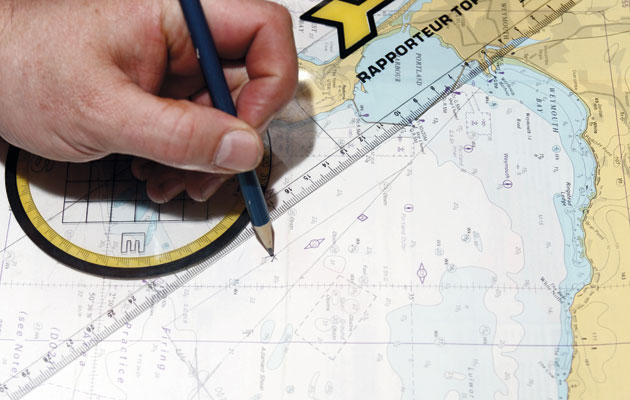
Your chartwork should be fluid and accurate
Skilled chartwork comes with use, and no amount of last-minute swotting can make up for weeks of doing it as a matter of course. Plotting traditional fixes is a good giveaway these days. With GPS all around us, we only do this for real when electronics fail. I’ve seen a person take 15 minutes to select three objects from a background studded with lights, then plot the results. The yacht had moved over two miles in the meantime…

It’s absolutely vital that you maintain a decent logbook during the exam
It’s absolutely vital, whether navigating with a giant chart plotter or a Walker log, that you maintain a decent log book. Without this, if GPS fails for any reason at all, you’re lost, Mate, so is your exam, and quite right too!
Take command
One of the most important questions on most examiners’ private lists is how good the candidate is at taking charge. If he’s managing well, we probably won’t even notice that he’s in command, that his crew all know what’s expected of them and that their skipper is quietly checking that they’re doing it. Good leadership is seldom about barking orders, and never about ignoring all on board, yet leadership is what being a Yachtmaster is all about. First, you must be sufficiently comfortable with your own skill levels not to have to worry about little things like picking up a mooring. Only then can you consider what may go wrong for the poor soul on the foredeck in a gale at midnight.
The classic skills
These are what most people imagine success in an exam is based upon. Actually, these basic skills merely help an examiner build up an overall picture of the candidate. It’s generally not a hanging matter if one manoeuvre goes a bit haywire. Even a grounding is often more interesting for what the candidate does about it than for the fact that it has happened. After all, nobody is perfect, especially under the stress of an exam.
Man overboard
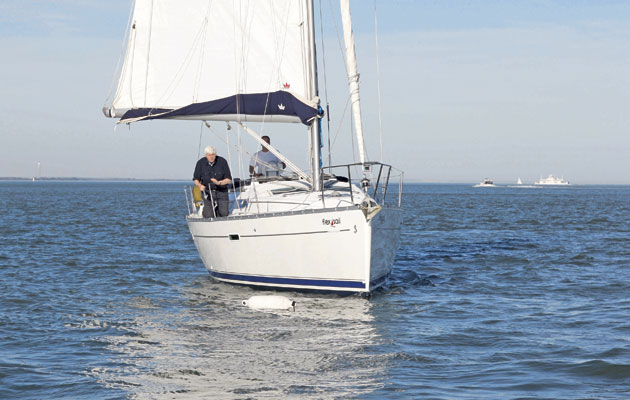
An effective, confidently executed man overboard drill speaks volumes about a candidate’s boat-handling ability but it’s not necessarily curtains if the manoeuvre goes a bit haywire
Errors in principle are not popular with examiners. Mistakes under pressure may sometimes be forgiven, and man overboard is a case in point. If the boat sails past the dummy with her mainsail full and the examiner asks, ‘What went wrong?’ It won’t get you much of a score if you reply, ‘I was going too fast.’
‘Candidate’s speciality, stating the bleeding obvious,’ the examiner will note on his pad, and move on, downhearted.
However, if you say, ‘I’m kicking myself because I was too far upwind and couldn’t de-power the main. I tried to get onto a close reach but I misjudged my approach,’ he’s more likely to take a lenient view – especially if you’ve opted for ‘Coastal’.
Securing the yacht alongside
When I was examining instructors regularly, I’d often sail up to Poole Quay (a tidal wall) shortly before closing time. I’d hop off the boat as soon as she touched the piling, saying, ‘You sort her out, skipper, I’m off for a quick pint.’ I’d then do just that. When I returned 10 minutes later, if the yacht was neatly snugged down with four lines ashore, ends on the dock, a fender board in place, sails neatly stowed and all hands below cooking and relaxing, the guy was in good shape for a pass. If I found discussions on deck about whether to ‘hand the end back for a spring’, and people blundering about in the dark, things didn’t look so bright for our hero. Have a system and know how to execute it.
… and don’t forget
Mooring and anchoring

Mooring and anchoring under sail should present no challenge to the aspiring Yachtmaster. When in doubt, drop the mainsail
These are Day Skipper skills that should pose no threat to a Yachtmaster candidate. Under sail, just remember first to assess whether the wind is with or against the tide. If you get lucky and it’s against, drop the main and arrive stemming the stream, spilling under headsail or creeping along under bare poles. If wind and tide are at all ambiguous, never forget the old adage – when in doubt, drop the mainsail.
Meteorology
As forecasting has become more comprehensive and accessible, I’ve noticed a reduction in candidates’ capacity to understand what’s going on and to read a bulletin creatively. Anyone who can’t describe the typical cloud sequence on a North Atlantic depression gets nil points from me, and failure to understand the basics of air masses is going to run up a black mark too. A favourite with examiners is to produce a weather map and invite their Yachtmaster to analyse it. Be ready, and know your subject.

Tom sees no reason not to have a chart in the cockpit, but some examiners disapprove of it. Be ready to justify your choice
Many candidates produce excellent pilotage plans for entering a strange harbour. I’m happy with that, and most examiners love it. Personally, I prefer to sketch a few notes on the actual chart and have it in the cockpit held down with a winch handle, yet I’ve met examiners who’d be horrified to see a chart on deck at all. So there you have it. Do what suits you best, then be ready to justify your choice. Actually, this advice is good across the board. The examiner wants to see what you really do, not some fantasy you’ve cooked up because you think he might like it. That is a weak candidate’s policy and it often backfires.

No shortcuts here, you just need to know your stuff – and finding the time to learn isn’t difficult
So far as the MCA is concerned, this is the crunch. Examiners are encouraged to demand high standards in this subject, and there’s no reason for a candidate, knowing full well he is to be put on the griddle, not to have the regulations burned into his heart. The best way to be exam-proof is to invest in A Seaman’s Guide to the Rule of the Road, available for modest money from all good chandlers or Bookharbour.com. Place it prominently in the heads some months before the exam and devote five minutes of the shining hour each day to digesting its wondrous contents. The book makes it easy and there’s no excuse for disappointing the Board of Trade!
For all the latest from the sailing world, follow our social media channels Facebook, Twitter and Instagram .
Have you thought about taking out a subscription to Yachting Monthly magazine?
Subscriptions are available in both print and digital editions through our official online shop Magazines Direct and all postage and delivery costs are included.
- Yachting Monthly is packed with all the information you need to help you get the most from your time on the water.
- Take your seamanship to the next level with tips, advice and skills from our expert skippers and sailors
- Impartial in-depth reviews of the latest yachts and equipment will ensure you buy the best whatever your budget
- If you are looking to cruise away with friends Yachting Monthly will give you plenty of ideas of where to sail and anchor
RYA Yachtmaster Coastal / Yachtmaster Offshore Prep & Exam
Preparation course overview.
The RYA Yachtmaster Coastal / Yachtmaster Offshore Preparation course enables those who hold the required prerequisite experience to sit the RYA Yachtmaster Coastal or RYA Yachtmaster Offshore exam to fine tune their existing skills prior to sitting the practical exam.
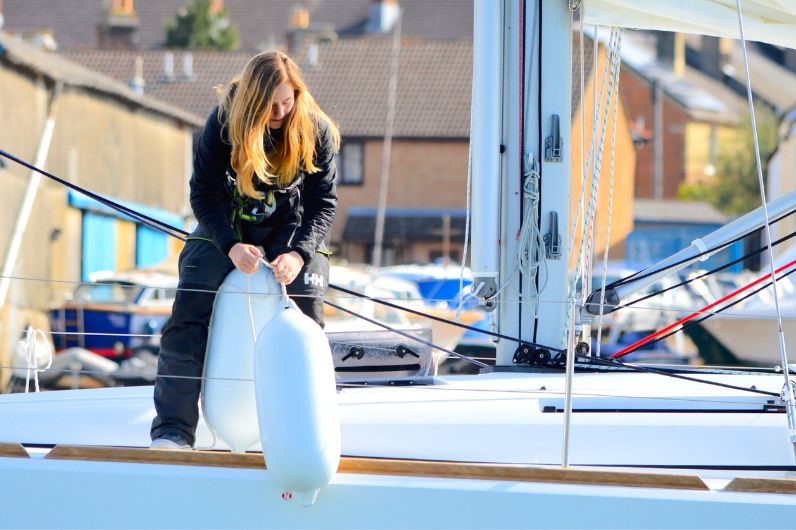
About the course
The preparation course is run over 5 days and designed to assess your level of competency against the RYA Yachtmaster Coastal or RYA Yachtmaster Offshore exam syllabus found in the RYA Yachtmaster Scheme Syllabus and Logbook (G158/15) and is intended to fine tune your existing skills and polish any areas of weakness prior to the exam. The subsequent exam is then run over two days, following the preparation course.
Prior the prep course, we advise that you read the exam syllabus and give yourself an honest appraisal of your strengths and weaknesses. Try to address any shortfalls beforehand and then during the preparation course be open with your instructor about your abilities and what you need to work on in the run up to your exam.
During the prep course your instructor will frequently update you on your progress and ability and recommend which exam you should aim for – whether Coastal or Offshore.
The syllabus is taught in a ratio of (4:1) students to instructor.
Prerequisites
Rya yachtmaster coastal exam (sail).
Candidates must be aged 17 or over and require;
- A Radio Operators Qualification – A GMDSS Short Range Certificate (SRC) or higher grade of marine radio certificate
- A valid first aid certificate
- Seatime – 800 miles logged within 10 years prior to examination, 30 days living on board, two days as skipper and 12 night hours.
For holders of the RYA Coastal Skipper Practical course completion certificate, the seatime requirement is reduced to 400 miles, 2 days living on board, 12 night hours, two days as skipper.
Half of the qualifying seatime must have been gained in tidal waters. For sizes of vessel please refer to page 73 in the RYA Yachtmaster Scheme Syllabus and Logbook (G158/15).
RYA Yachtmaster Offshore Exam (Sail)
Candidates must be aged 18 or over and require;
- Seatime – 50 days, 2,500 miles, including at least five passages over 60 miles, acting as skipper for at least two of these passages and including two which have involved overnight passages. Five days’ experience as skipper.
At least half of the qualifying seatime must have been accrued in tidal waters. For sizes of vessel please refer to page 73 in the RYA Yachtmaster Scheme Syllabus and Logbook (G158/15).
Full details and definitions on qualifying passages can be found here .
Exam overviews
The exam will include an assessment of your skippering skills, boat handling, general seamanship, navigation, safety awareness and knowledge of the IRPCS (collision regulations), meteorology and signals. You will be set tasks to demonstrate your ability and may also be asked questions on any part of the syllabus for all practical and shorebased courses up to Yachtmaster Coastal level.
The exam will include an assessment of your skippering skills, boat handling, general seamanship, navigation, safety awareness and knowledge of the IRPCS, meteorology and signals, with particular emphasis on command skills, boat handling under sail and power in confined spaces, plus navigation and pilotage techniques in daylight, at night and in reduced visibility. Adverse weather conditions and coping with emergencies are also covered.
The examiner will set tasks to enable you to demonstrate your ability as skipper and may also ask questions on any part of the syllabus for all practical and shorebased courses up to RYA Yachtmaster Offshore.
Exam Duration
The exam will take around 8-12 hours per candidate candidate. No more than two candidates can be examined in 24 hours. Whilst one candidate is being examined the remaining candidates will act as crew.
Qualifications
RYA Yachtmaster Coastal Certification of Competence.
RYA Yachtmaster Offshore Certificate of Competence.
Dates and pricing
Register your interest.
- First name *
- Last name *
- How did you hear about UKSA? * –None– Cowes Harbour Handbook Event Facebook General Knowledge Google Ads Instagram Outdoor collateral Press Referral RYA Dinghy Show School trip Solent Handbook & Directory Southampton Boat Show The British Boat Owners Directory Website
- General notes
- Opt-in to receive course information and relevant offers
- Accept Privacy Policy and Terms and Conditions .
- Comments This field is for validation purposes and should be left unchanged.
You may also be interested in
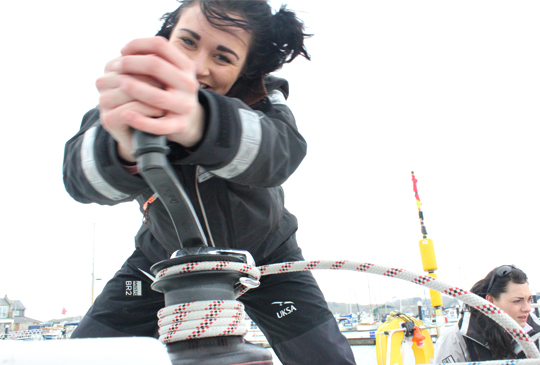
Need help finding the right course for you?
Speak to an advisor on +44 (0)1983 203001 or email us

RYA Sailing Courses
Rya yachtmaster coastal and offshore – prep course and exam.
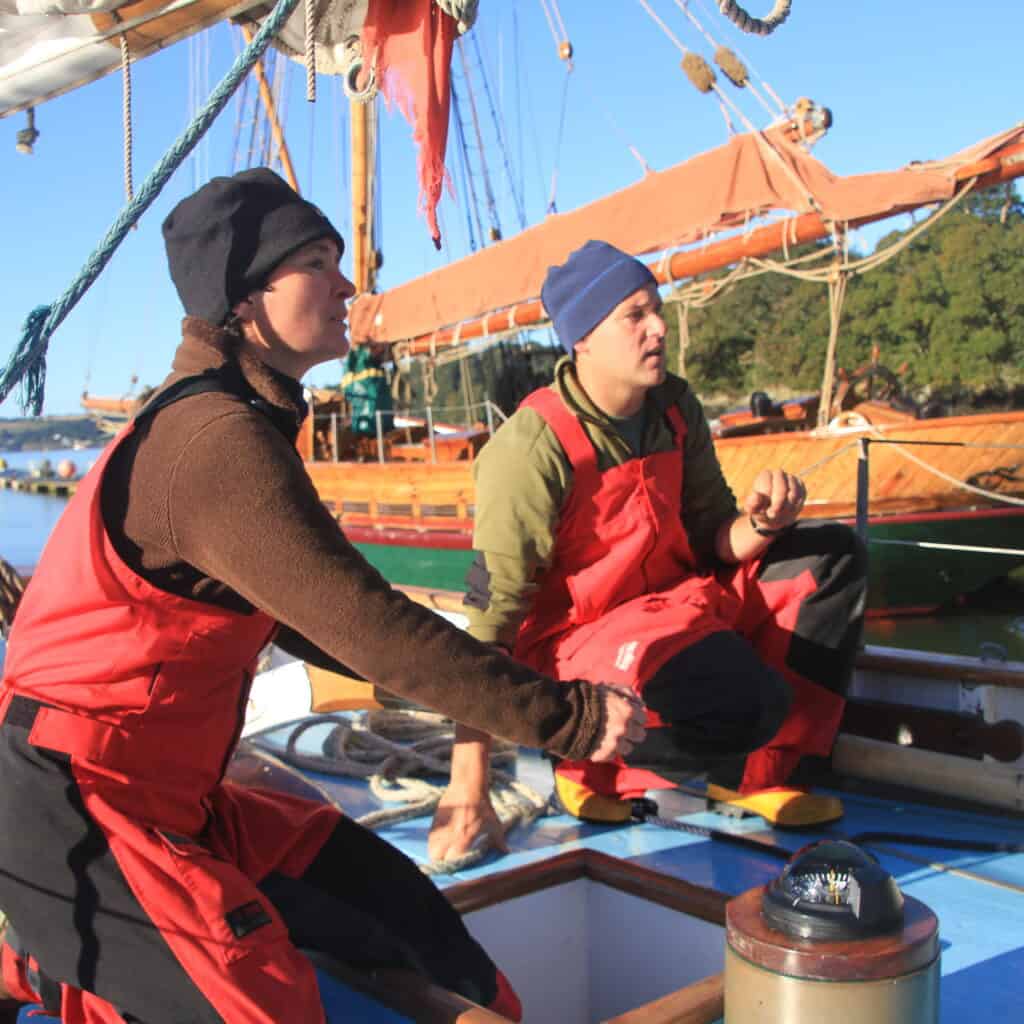
RYA Yachtmaster Offshore or RYA Yachtmaster Coastal Certificate – Prep Course & Exam
An RYA Yachtmaster Offshore Certificate is the ultimate sailing qualification for UK sailors and for many aspiring professional sailors around the world. Whether you want the Yachtmaster Certificate of Competency to be able to charter yachts as skipper anywhere in the world, as proof you have reached the pinnacle of your leisure sailing ambitions, or you need it for a sailing career, you will need to pass the exam. It is nautical equivalent of a driving license, no matter if you are into racing yachts, classic boats, super yachts or motor boats.
If you pass and meet the pre-requisites to convert it into a commercially endorsed MCA/RYA Certificate of Competency, you are legally qualified to skipper a vessel up to 24 metres or up to 200 tonnes.
Why do a Yachtmaster Preparation Course ?
Unlike other courses in the cruising programme, there is no formal training to complete in order to become a Yachtmaster Offshore. Instead, provided that you have sufficient experience and seatime (see pre requisites), you can put yourself forward for an exam to test your skills and knowledge. This exam takes place on an approved yacht with an external RYA examiner testing both your practical skills and your theoretical knowledge over 5-9 hours per candidate, or slightly longer if you are the only candidate being examined.
Our Yachtmaster Prep course has a generous 5 days (more than most schools) and 2 days set aside after the course for those that feel ready to take the exam.
Benchmark for a Successful Exam Pass
If you have not completed a shore based Coastal skipper/Yachtmaster theory course then please check the syllabus to make sure you are confident with your theoretical knowledge (especially Rules of the Road IRPCS) and the practical application of navigational skills. We can now offer you a Long Distance Yachtmaster Coastal/Offshore Theory Course, which gives you the option of when, where and for how long, you study.
A RYA Yachtmaster Coastal (formerly Coastal Skipper) should have the knowledge to skipper a yacht on coastal cruises but does not necessarily have the experience needed to undertake longer passages.
A RYA Yachtmaster Offshore should be able to enter any well-charted harbour for the first time, with sufficient depth, by day or night. The only way to gain confidence is by practice, particularly at night when skill is required in picking out navigation lights and buoys against a background of shore lights. (If you have colour blindness please talk to us before booking)
With a course over 7 days, your fully qualified instructor will be able to devote plenty of time to your individual needs with regular debriefings and coaching aimed at helping you to raise your standards.
Fee’s for Yachtmaster Certificate preparation
Voyage fee is for the full 5 days of instruction (or 8 days if you go on to do the exam)
Examination fee payable to the examiner -RYA Yachtmaster offshore Exam is £215 and Yachtmaster Coastal is roughly £185 per person (2019).
Yachtmaster Coastal Pre Exam Requirements
Radio Operators Certificate – for example (restricted) VHF Radio Operators Certificate or a GMDSS Short Range Certification or higher grade marine radio qualification.
Valid First Aid Certificate – First Aid certificates held by police / fire or armed servicesare also acceptable.
Seatime – 800 miles logged within 10 years of the examination. 30 days on board. 2 days as skipper and 12 night hours. (half the qualifying seatime must have been conducted in tidal waters)
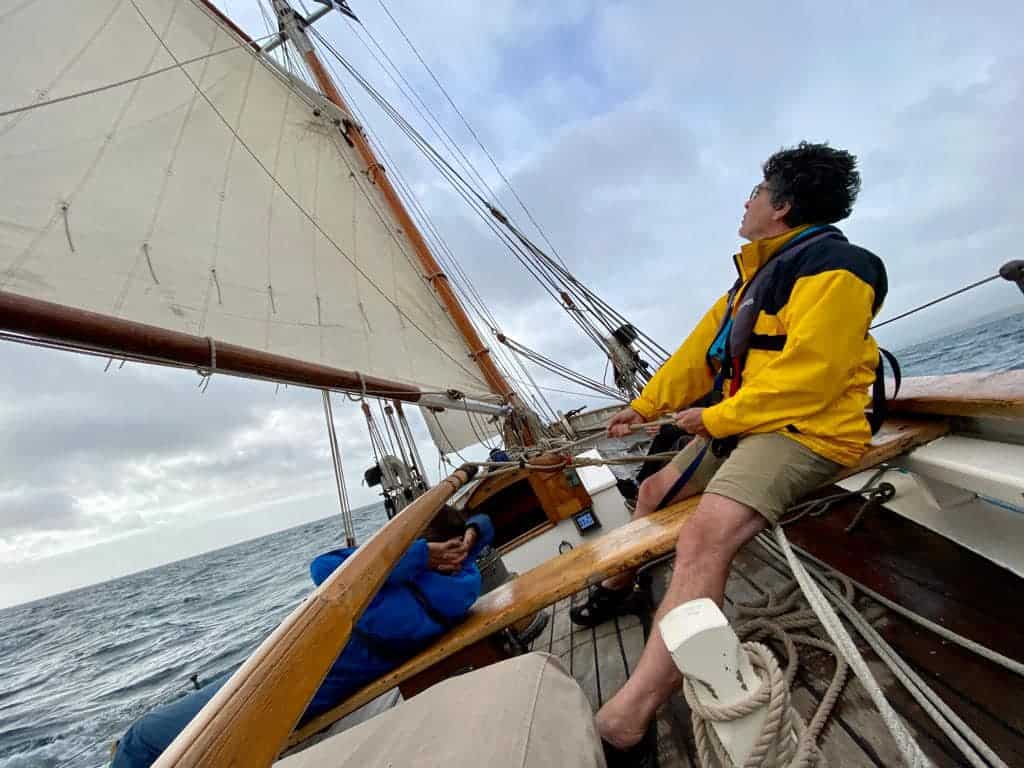
Yachtmaster Offshore Pre Exam Requirements
Seatime – 2500 miles. 50 days on board. At least 5 passages over 60 miles and acting as skipper for at least 2 of these passages and including two which have involved overnight passages.
Skipper experience – at least 5 days as skipper. (Half the qualifying seatime must have been conducted in tidal waters)
50 Days seatime & 5 days as skipper – 2500 miles logged – 5 passages over 60 miles -including 2 overnight and 2 as skipper. Qualifying passages must be over 60 miles non stop by the most direct route and involve no change of skipper during the passage.
Bring with you to the exam
RYA logbook or evidence of your sailing experience and qualifying passages
- Passport photo
- cheque or credit card details for Exam fee payable to the RYA
- First Aid Certificate
- VHF Radio Operators Certificate
- You must be over 18 years of age & qualifying experience gained over the age of 15.
- Certification required before the examination:
- VHF Radio Operators Certificate – First Aid Certificate

Blog search
Latest Posts
02/28 Educational
2024 – Classic Sailing’s Year of Skills: Confident Crew
02/01 Boat building
2024: Classic Sailing’s Year of Skills! It’s not just sailing, you know!
01/14 Inspiration
Turning the Tide on Blue Monday
10/11 Climate Change
Science & Sailing: Ocean Warrior #Resolute Expeditions
03/16 Educational
Why I love the gig boats.
03/07 Book Reviews
Resilience & Wit in the 1890s
02/29 Ocean Warrior
Ocean Warrior – Transparency in Costs
RYA Day Skipper Practical Course
RYA Professional Practices and Responsibilities
More Stories
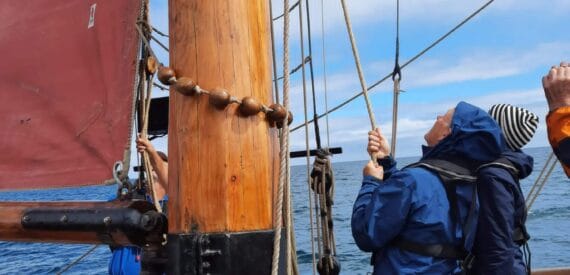
28/02 Educational
Throughout 2024, we’re shining the spotlight on the various ways our customers get more with a Classic Sailing booking. Sailing on a traditional vessel

01/02 Boat building
Throughout 2024, we’re shining the spotlight on the various ways our customers get more with a Classic Sailing booking. There are many physical and
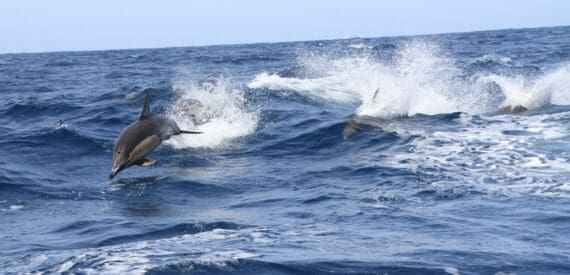
14/01 Inspiration
Turning the Tide on Blue Monday Blue Monday, marked on 15th January 2024, is here again. Many of us find ourselves caught in the
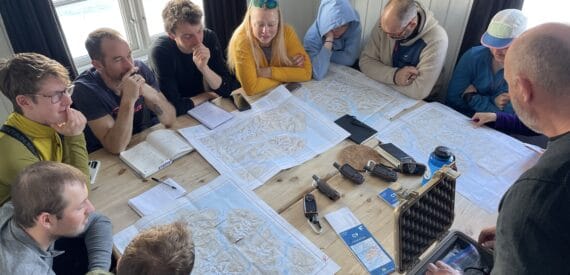
11/10 Climate Change
I couldn’t praise the Linden crew highly enough, extremely professional, friendly and encouraged us to be part of the team. I’d sail on that
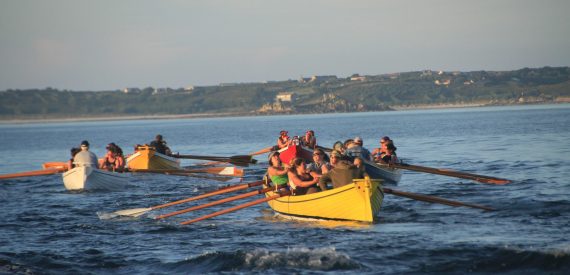
16/03 Educational
I grew up in St Mawes, Classic Sailing’s home base, and learnt to row in the harbour when I was about 7 years old
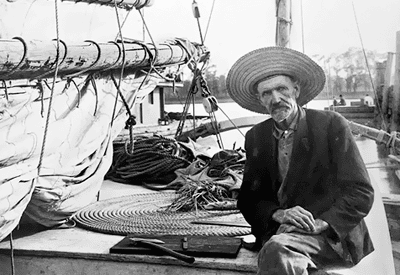
07/03 Book Reviews
Sailing Alone Around the World Joshua Slocum was the first man to circumnavigate the world solo, a feat he accomplished between 1895 and 1898
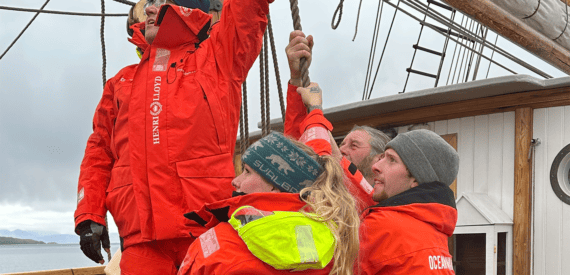
29/02 Ocean Warrior
TRANSPARENCY IN COSTS: A CLOSER LOOK In a world where honesty and integrity reign supreme, Ocean Warrior stands firm in its commitment to transparency.

Yachtmaster Exam Preparation
The boat school 5-day yactmaster preparation course (sail) is an intensive course to hone your practical skills before you take the the rya yachtmaster coastal or offshore exam. depending on your skill level and experience, you can elect to take the yachtmaster exam at the coastal or offshore level., quick facts, read the requirements carefully, 5-day intensive practical course, optional 2-day theory refresher, taught by our chief instructor · sail, allow 9 days for the course & exam.

The details
- You'll learn
- Requirements
Depending on your skill level and experience, you can elect to take the Yachtmaster exam at the Coastal or Offshore level. The preparation is exactly the same; however, the requirements are different (see the tab “requirements”) and the examiner will be looking for a higher level of ability at the Offshore level. You can choose which level to apply for anytime before the actual exam date and, if you’re uncertain, your instructor can help you decide during the course.
Although the Yachtmaster exam is essentially practical, candidates are expected to demonstrate a sound knowledge of navigation (including tidal streams and heights), weather and forecasts, collision avoidance, pilotage and passage planning. For this reason, at The Boat School, we always run a 2-day theory refresher immediately before the 5-day practical course. You can opt out of this refresher, but we highly recommend doing the course even if you think your theory is up to scratch!
We will book your RYA Yachtmaster exam for dates immediately following the Prep course. In most cases, the exam will last two full days. In arranging travel, you should therefore plan to spend 7 full days with us, or 9 full days if you elect to do the theory refresher.
The Boat School course to obtain the RYA Coastal Skipper (Sail) certificate is taught in small groups with a maximum of four Yachtmaster candidates.
Is this course for me?
You can choose to complete the course either as part of an open group or you can rent a boat for the day and complete the course with family and friends.
Open groups With an open group booking, you book a place on a course and we’ll admit up to a maximum of four students onto that same course. This is the most economical option; however, it’s also the least flexible option if your availability is limited. The price of a seat on an open course includes fuel and mooring fees away from our base.
We schedule courses in accordance with the availability of students interested in the course. Please contact us for details of the next course.
Rental & course pack With this option, you charter a sailing yacht and we provide the instructor and teaching materials. This option gives you maximum flexibility in terms of dates and the option to choose the boat on which you’ll be learning (subject to availability). As with any charter, you’re responsible for paying the fuel for the boat as well as mooring fees away from our home port.
Rental with tuition: please ask us for a personalised quotation
Own boat tuition If you already own a yacht, or if you have a friend who owns a sailboat, we’re more than happy to run this course on your own boat. This option is significantly cheaper than open groups and charters; however, you do need to make sure that your boat is up to the standard required by the RYA for training.
What’s included? Your RYA Yachtmaster Prep course with The Boat School includes:
- Use of a coded sailboat during the course and exam
- Use of light-weight inflatable life jackets
- Cold water on the boat
- Fuel and mooring fees (open groups only)
This course includes accommodation aboard for the complete duration of the course; however, we cannot guarantee that you will have your own cabin (this depends on the type of yacht used for your course). We do guarantee:
- Couples (or friends) will have their own cabin
- Female participants will only share a cabin with other female students
- Please contact us if you have any questions about accommodation
What’s not included? RYA examiners fee and travel expenses.
The exam can require you to demonstrate knowledge and competence across a very wide ranging syllabus (see Logbook G158 pages 74-76.) so the Yachtmaster preparation programme will be demanding and hard work. You can expect to be working long days and into the evening. During the Yachtmaster Prep course your instructor will frequently update you on your progress and ability and recommend which exam you should aim for – Coastal or Offshore. Below is a list of the prerequisites you need before you can take the exam together with the documentary evidence you will need to present. This documentary evidence will be reviewed by the examiner at the start of exam. If it is not complete, the exam cannot continue. To be absolutely clear, you will not be permitted to take the exam if any of the following does not meet the required standard. However, you will still be charged for the use of the vessel, and may also be liable to cover the costs of the examiner’s time and travel.
All the information below is also available in the RYA Yachtmaster Scheme Syllabus and Logbook, (G158) available from the RYA (www.rya.org.uk).
Coastal Yachtmaster Exam
- Minimum 17 years old
- A valid radio operator’s licence (SRC -or equivalent- or higher)
- A valid current First Aid Certificate (see RYA website for acceptable certificates)
- Minimum of 800 sea miles logged within the last 10 years (half the miles logged MUST HAVE BEEN in tidal waters)
- 50% of sea time must be in vessels of 7-24m LOA
- 30 days at sea (20 days if you have completed the RYA Coastal Skipper certificate)
- 2 days as skipper
- 12 night hours
Offshore Yachtmaster Exam
- Minimum 18 years old
- Minimum of 2500 sea miles logged within the last 10 years, of which at least 1,250 MUST HAVE BEEN in tidal waters.
- 50 days living on board
- 5 days as skipper
- 5 passages of over 60 miles . Of these you must have been skipper for a minimum of 2 passages.
- A minimum of 2 qualifying passages must have been overnight.
- Qualifying passages must have been in vessels of 7-24m LOA
Find out more about the RYA Yachtmaster Offshore Exam
Book your yachtmaster preparation course, book a place in an open group, rental with course pack or own boat tuition.
The option of chartering one of our sailing yachts or running the course on your own boat gives you maximum flexibility whether you’re looking for a small group (up to 5 students) or you want one-to-one training. You can choose between:
Yachtmaster Preparation
Coastal & Offshore
Ready to book? Got any questions?
Or give us a call on:
Call an RYA Boat School instructor on: 639202297
We'd be delighted to talk you through different course options and send you a personalised proposal if you need a package of courses.
The Boat School
Recognized by the Royal Yachting Association to conduct Powerboat Training, Sail Cruising courses in the Yachtmaster (sail) scheme and Shorebased (theory) courses.
Recognized by the Spanish Directorate General for Merchant Shipping, the Comunidad Valenciana and the Region of Murcia to conduct sail, motor, powerboat and VHF training.

Operational Base Denia
Marina de Dénia (Sail courses) Darsena de babor s/n 03700 · Denía Alicante · Spain Click to call
Marina El Portet (Powerboat courses) Moll de la pansa, s/n 3700 · Dénia Alicante · Spain Click to call
Classrooms & pick up for certificates Carrer de Fora Mur, 12 03700 · Dénia Alicante · Spain Click to call
Madrid Office
Greenwich Náutica C/ Marqués de Lema 7, Local 6 28003 · Madrid Spain Click to call
Register today and get £50 off
Enter voucher code HOME STUDY in the booking form
Coastal / Offshore
RYA Yachtmaster
Online Theory Course
A challenging course which stretches you but backed up with excellent coaching and instructor support.

Advanced training for more experienced skippers to navigate safely on coastal and offshore passages
The RYA Yachtmaster online theory course takes your theory knowledge to the standard required for the Yachtmaster Coastal and Yachtmaster Offshore practical exams.
This course advances your skills as a skipper of a yacht or motor boat, with an emphasis on navigation and passage planning for more complex coastal or offshore passages by day and night
Includes some time for the revision of Day Skipper subjects then moves on to cover a greater depth of knowledge and more advanced skills in navigation, pilotage & meteorology.
Successfully gaining your RYA Yachtmaster theory certificate will enable you to confidently work towards your Yachtmaster Coastal or Yachtmaster Offshore practical qualification.
- Assumed knowledge To Day Skipper theory level.
- Minimum duration A minimum of 40 hours of course study time is specified by the RYA, plus time for exercises and exams.
- Ability after course Theory knowledge to skipper a vessel on coastal and offshore passages by day and night.
Simply click below to try a free lesson.
Pilotage for RYA Yachtmaster Offshore
- Charts & Other Publications
- Definition of Position, Time, Speed & Distance
- The Compass (including allowance for deviation and swinging the compass)
- Tidal Theory
- Tidal Heights (including secondary ports)
- Tidal Streams (including interpolation of drift)
- Estimated Position
- Course to Steer
- Visual Aids to Navigation
- Electronic Aids to Navigation
- Passage Planning
- Meteorology (including interpreting surface pressure charts)
- The Collision Regulations
- Safety & Protection of The Environment
Unlimited support from our dedicated RYA Instructors - 365 days a year via email, phone or Skype/Zoom.
14-day unconditional money-back guarantee.
17 fully-narrated online lessons including animations, videos and realistic 3D graphics.
Embedded quizzes with instant feedback in each lesson.
14 self-assessment exercises with fully worked answers.
Over 50 downloadable or linked resources.
Videos covering: updating paper charts, engine checks, dismasting, jury rig, flood control, firefighting, gas explosions, capsize, lifejacket checks, how to put on a lifejacket and what happens when it inflates, man-overboard recovery, launching and boarding a liferaft.
Free Radar course.
RYA Student Pack (including 2 training charts, training almanac & course handbook).
Mock exams to prepare you for the real thing and give you the confidence to pass.
3 final online exams with detailed instructor feedback and free repeat attempts if requried.
RYA Yachtmaster Shorebased Theory Course Completion Certificate.
12 months access to study with instructor support and exams - you can extend this if you want.
Lifetime access to training materials once you’ve completed the course.
Optional Extras
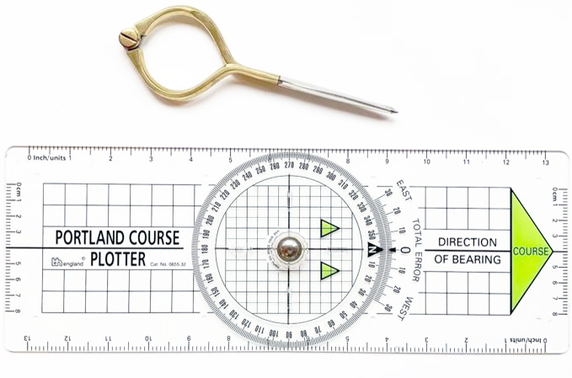
Plotter and divider You’ll need a course plotter and chart-dividers to complete the chartwork exercises - if you don’t already have these you can purchase a top quality set from us for £28 when you place your order.

Delivery UK delivery is free. European delivery is £20, outside Europe delivery is £40.
You can start studying immediately as many of the lessons don’t rely on the printed support materials.
This course is accessed online with no additional software required.
Lessons are accompanied by optional professional narration, and notes.
They are intuitive and easy to follow, whilst more complex subjects are accompanied by interactive animations and graphics to help you gain a full knowledge of each subject in the course syllabus.
Detailed step-by-step workings for navigational or tidal calculations make it easy for you to follow along as we show you how to plot positions, make tidal height and stream calculations, etc
You can go over these again and again, and test your knowledge with regular quizzes throughout each lesson.
At the end of each lesson there is an excercise containg similar questions to the exam, with detailed and illustrated answers sent to you immediately to confirm your progress and fully prepare you for your mock and final exams.
You can repeat entire lessons and excercises as often as you wish until you are confident that you fully understand each subject.
When you have completed the course you can request mock and then final exams.
These are assessed by our RYA Instructors and detailed feedback is provided in any areas that may require further study within the course.
If you pass the final exams you will be awarded the RYA/MCA Coastal Skipper & Yachtmaster Offshore Shorebased Course Certificate , which will be posted to you.
Additional free resits, with suitable Instructor guidance, are available if required.
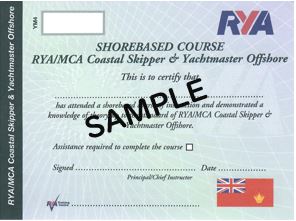
Call us for advice on 0238 218 2604
Course reviews.
Laura Anderson
Very enjoyable and informative
Impressively prompt and thorough feedback on all queries, tests, mock and real exams. Very high standards and you feel you have earned the Yachtmaster certificate.
Ciaran McIntyre
Comprehensive and well delivered
Excellent course materials and high quality delivery. Very responsive and excellent instructor feedback
Andrew Harvey
Excellent Yachtmaster theory course - I’d definitely recommend it.
Does what it says on the tin and more. I was impressed how well the course managed to tackle teaching relatively complex skills in a logical and easy to understand way.
Oliver Fleming
Well put together course.
I found the Yachtmaster theory course to be really well structured and covered all of the syllabus in great detail. I was impressed by how well the course managed to tackle teaching relatively complex skills in a logical and easy to understand way.

Combined - RYA Day Skipper & Yachtmaster to fast track your theory learning
Best Coast Water Sports
BCWS is your go-to source for all things related to water sports

How to Become a Yacht Master: A Step-by-Step Guide
Becoming a Yacht Master is an exciting and rewarding journey that allows you to combine your passion for sailing with a promising career path. This comprehensive guide will provide you with the essential steps to becoming a Yacht Master, including understanding the role, meeting prerequisites, obtaining certification, gaining practical experience, advancing your career, and tips for success.

How to Become a Yacht Master in the RYA
To become a Yacht Master in the Royal Yachting Association (RYA), you will need to complete a series of courses and gain the necessary experience.
Here are the steps you can take to become a Yacht Master in the RYA:
- Gain experience : You will need to have a certain amount of experience before you can start working towards your Yacht Master qualification. This usually involves logging a minimum number of sea miles and completing a certain number of hours of helm time.
- Complete the Day Skipper course : This course will teach you the basics of navigation, seamanship, and boat handling. It will also give you an introduction to basic weather forecasting and how to plan a passage. You will need to complete this course before you can progress to the Coastal Skipper and Yacht Master courses.
- Complete the Coastal Skipper course : This course builds on the knowledge and skills gained in the Day Skipper course and focuses on more advanced navigation and boat handling. You will learn about night navigation, pilotage, and passage planning.
- Gain more experience : After completing the Coastal Skipper course, you will need to gain more experience before you can start working towards your Yacht Master qualification. This usually involves logging more sea miles and completing more helm time.
- Complete the Yacht Master theory course : This course covers advanced navigation, meteorology, collision regulations, and safety at sea. It is designed to give you the knowledge required to navigate safely in more challenging conditions.
- Complete the Yacht Master practical exam : This is the final step in becoming a Yacht Master in the RYA. The exam consists of a practical assessment of your boat handling skills, navigation ability, and safety knowledge.
Note that there are different types of Yacht Master qualifications available, depending on the type of vessel you want to operate and the waters you want to sail in. Make sure to choose the qualification that is appropriate for your goals and experience level.
Understanding the Role of a Yacht Master
The Yacht Master is a highly skilled professional responsible for the safe operation and overall management of a yacht. To fully grasp the requirements of this role, it is important to examine both the responsibilities and qualifications involved.
Responsibilities and Duties
Being a Yacht Master comes with a significant set of duties and responsibilities. These include, but are not limited to, ensuring the safety of passengers and crew, managing all onboard operations, maintaining legal and regulatory compliance, and supervising the maintenance and repair of the yacht. Additionally, Yacht Masters often need to act as navigators, assuring the timely arrival at planned destinations while taking into account the weather, sea conditions, and other potential hazards.
Skills and Qualifications
Aspiring Yacht Masters must possess a wide range of skills in order to excel in this demanding profession. Some key qualifications include excellent communication and leadership skills, a strong background in sailing and seamanship, knowledge of navigation and meteorology, mechanical aptitude, and the ability to remain calm under pressure.
Prerequisites for Becoming a Yacht Master
Before starting your journey to become a Yacht Master, you should consider the prerequisites to ensure you are on the right path.
Sailing Experience
Hands-on sailing experience is essential for building the foundation of your Yacht Master career. This includes recreational sailing or working on crewed vessels in various capacities. Many aspiring Yacht Masters begin by obtaining entry-level roles within the yachting industry, such as deckhand or mate, to gain valuable experience.
Required Certifications and Licenses
There are several certifications and licenses required to become a Yacht Master. The specific requirements may vary depending on the jurisdiction where you plan to work, but most countries require the completion of various sailing and navigation courses, like the RYA (Royal Yachting Association) Yacht Master program. These courses and certifications demonstrate your knowledge, skills, and commitment to the profession.
Physical Fitness and Health Requirements
Being a Yacht Master is a physically demanding profession that requires individuals to maintain a high level of fitness and health. It is important to assess your physical abilities and conditions to ensure you can meet the demands of the job. Additionally, some jurisdictions require a valid seafarer’s medical certificate, attesting to your overall health and fitness for work at sea.
Yacht Master Training and Certification
Once you have met the prerequisites, the next step is to obtain the necessary training and certification to become a Yacht Master.
Choosing the Right Training Program
It is crucial to choose a reputable and accredited training program. Look for programs with experienced instructors, proven success rates, and comprehensive curriculums that cover essential topics. The RYA Yacht Master program is one of the most recognized and respected certification systems worldwide.
Essential Courses and Modules
A typical Yacht Master training program consists of multiple courses and modules. Common subjects include navigation, seamanship, meteorology, safety at sea, engineering, and radio communication. Additionally, practical skills such as boat handling, sail trim, and emergency procedures are also covered extensively.
Preparing for the Yacht Master Examination
To become a certified Yacht Master, you must successfully pass the Yacht Master examination. This comprehensive exam assesses your theoretical knowledge, practical skills, and ability to safely command a yacht. It is crucial to dedicate ample time to studying and practicing before attempting the examination to ensure success.
Gaining Practical Experience
Once you have obtained your Yacht Master certification, the next step is to gain practical experience.
Building Sea Miles
Accumulating sea miles is important for both building your skills and enhancing your employability. You can do this by participating in sailing deliveries, joining yacht races or rallies, and working on crewed charters. Each of these experiences will help you become a more proficient sailor and better prepare you for the demands of being a Yacht Master.
Networking and Finding Opportunities
Networking is crucial for securing opportunities in the yachting industry. Attend industry events, join online forums, and connect with fellow sailors to build relationships and stay informed of job openings. This will not only help you find employment but also provide invaluable support and guidance throughout your career.
Learning from Experienced Yacht Masters
Seek out opportunities to learn from and work closely with experienced Yacht Masters. Building a mentorship relationship with someone who has already achieved success in the profession can provide invaluable insights, advice, and practical tips to help accelerate your own career.
Advancing Your Yacht Master Career
Once you have gained experience and established yourself as a competent Yacht Master, it is important to look for ways to advance your career.
Continuing Education and Professional Development
Investing in your ongoing education and professional development is essential for remaining competitive and staying updated on industry best practices. This can include attending industry conferences, enrolling in additional training courses, and obtaining specialized certifications to expand your skillset and expertise.
Joining Professional Associations
Joining professional associations, such as the RYA or the International Yacht Training (IYT) community, offers numerous benefits. These organizations provide access to networking events, job boards, professional resources, and continuous learning opportunities, all of which can help elevate your career.
Exploring Job Opportunities and Specializations
With experience as a Yacht Master, you can explore various job opportunities and specializations within the yachting industry. Some popular career paths include working as a captain of private or charter yachts, managing yacht operations and maintenance, and serving as a consultant or instructor. Pursuing a specialization can lead to increased job satisfaction, better employment prospects, and higher earning potential.
Tips for Success as a Yacht Master
To ensure a successful and fulfilling career as a Yacht Master, consider the following tips:
Developing Strong Leadership Skills
As a Yacht Master, you are responsible for leading and managing your crew. Developing strong leadership skills, such as effective communication, decision-making, and problem-solving, are essential to creating a harmonious and efficient onboard environment.
Staying Updated on Industry Trends and Regulations
The yachting industry is continuously evolving, and staying informed of the latest trends, technologies, and regulations is crucial. Regularly review industry news, engage with your professional network, and attend educational events to keep your knowledge current and maintain your relevancy in the industry.
Balancing Work and Personal Life
Finally, maintaining a healthy work-life balance is essential to your well-being and long-term success in the yachting industry. Set boundaries, prioritize self-care, and make time for personal interests and relationships to ensure you can enjoy a rewarding and enduring career as a Yacht Master.

Chieftain Training
RYA & STCW Courses – Sail, Power, Super-Yacht & Workboat
How to Pass the Yachtmaster Exam
Yachtmaster certificate of competence exam top tips, which yachtmaster.
First we need to be clear which Yachtmaster exam we are talking about. Leaving things like the Yachtmaster Instructor and Examiner Qualifications aside there are no less than 8 separate RYA certificates that are called “Yachtmaster”. This includes the 3 independently examined levels of Yachtmaster Certificate of Competence, (coastal, offshore and ocean).
RYA MCA Coastal Skipper & Yachtmaster Offshore Shorebased Course
( Yachtmaster Offshore Shorebased for short). This is a 6 day course which includes three written papers. It is assumed knowledge for all of the certificates that follow, so we will assume for the purposes of this article that you have already completed this course.
Yachtmaster Coastal Certificate of Competence (power or sail)
This certificate follows the successful completion of a practical exam which is discussed in this article. The exam can be taken on board a sailing yacht or motor boat, (and the qualification is endorsed for the relative type of craft). The Yachtmaster Coastal CoC certifies skippers to operate up-to 20 miles from a safe haven on board commercial vessels up-to 24m, carrying up-to 12 passengers. It can also be used as an entry requirement for super yacht Officer Training ( OOW 3000 ).
Yachtmaster Offshore Certificate of Competence (power or sail)
A higher level practical exam, also discussed in this article. This certifies skippers to operate up-to 150 miles from a safe haven on board commercial vessels up-to 2000 tonnes, (again with up-to 12 passengers). It can also be used as an entry requirement for super yacht officer training and is a requirement to progress onto Yachtmaster Ocean CoC (below) and/or MCA Master 200 .
RYA MCA Yachtmaster Ocean Shorebased Certificate
aka Ocean Shorebased . This is a 5 day (or 40 hour online) course which includes one written paper. It is assumed knowledge for the oral exam that follows and beyond the scope of this article. You can read all about the Ocean Yachtmaster Course and Exam here .
Yachtmaster Ocean Certificate of Competence (power or sail)
An even higher level certificate that qualifies the holder to skipper beyond the 150 mile from a safe haven limit of the Yachtmaster Offshore CoC. The Yachtmaster Ocean exam is an oral exam and one of its pre requisites is the Yachtmaster Offshore CoC (above).The Yachtmaster Ocean Exam is beyond the scope of this article, but by popular request we have written a separate article about it, MCA Yachtmaster Ocean Certificate of Competence .
RYA MCA Yachtmaster Coastal and Offshore Certificate of Competence Practical Exam
Getting back on topic this article specifically relates to the two practical exams (Coastal and Offshore), each can be taken onboard a sailing yacht or motor boat.
The exam for the Yachtmaster Coastal CoC and the Yachtmaster Offshore CoC is very similar and in fact different candidates can be examined together even if they are not taking the same level.
Exams are conducted with 1-4 candidates on board the vessel.
You can take the Yachtmaster exam on a sailing yacht or motorboat, and you will become a Sail or Power Yachtmaster as appropriate. This article covers sail and power exams as much of the advice is generic.
The RYA/MCA Yachtmaster qualification is the global standard for sailing and motor boating. The definition of a Yachtmaster Coastal/Offshore is: ‘A yachtsman or woman competent to skipper a cruising yacht on any passage that can be completed without the use of astro navigation.’
The RYA/MCA Yachtmaster Certificate of Competence remains the logical target of many a self-motivated sailor. It also represents the icing on the cake for those looking for the reassurance of an external assessment.
How long is the Yachtmaster Exam?
There can be up to 4 candidates on the boat with the examiner. A examiner will not conduct more than 4 exams at once and will not plan to examine more than 2 candidates in a 24 hour period. He/she will need to see each candidate skipper the boat underway by night.
Yachtmaster Coastal Exam Duration
- 1 Candidate – 6 to 10 hours
- More than one candidate – 4 to 8 hours each
Yachtmaster Offshore Exam Duration
- 1 Candidate – 8 to 12 hours
- More than one candidate – 5 to 9 hours each
For many candidates this means there will be a pause mid-exam while they and the examiner get some sleep before restarting in the morning. It is not unknown for exams to span two nights if there are 4 candidates (for example Friday evening 1800- Sunday morning 1100)
Listed below are some top tips to help you prepare for your RYA/MCA Yachtmaster exam.
Prepare early for your yachtmaster exam.
Most candidates spend some time with an Instructor, whether this is a 5-day preparation course with a sea school or some bespoke tuition on board their own boat. A half decent Yachtmaster Instructor will take you through many of the exercises that an Examiner will expect you to demonstrate and will put you in the mind-set of an exam candidate.
On the day of the exam make sure you are ready in good time so that you aren’t involved in a last-minute faff. If you’re relaxing in the cockpit with a cup of tea when the examiner arrives, the examiner will be more impressed than if you’ve put yourself under stress attempting to work out the day’s tidal heights or secondary ports last minute!
When given a navigation task, prepare fully, make notes, prepare pilotage sketches and plan well! Nip below every so often en route to keep an eye on what’s going on in the chart department and whizz back on deck pronto to carry on skippering the boat. Don’t panic and don’t spend all your time sat behind the chart table, taking no notice of what’s going on around you, this is an obvious sign of someone who is ill prepared for the passage they are skippering.
HAVE YOUR YACHTMASTER EXAM PAPERWORK READY (and the kettle boiling)
The very first part of the exam will be paperwork. Before the examiner can proceed he/she will;
- Ask for your completed exam application form, be sure it is completed in advance and details your qualifying sea time.
- Ask for payment, (the examiner can not proceed if you do not pay up front)
- Ask for sight of your Short Range Certificate , (or a pass form if you have recently taken the course and exam and are awaiting the actual certificate). Higher level GMDSS certificates are acceptable.
- Request a passport photo of you (write your name on the back).
- Chat with you about your yachting background and qualifying sea time
- Outline what he/she expect from you over the coming day(s).
If you are applying for a commercial endorsement at the same time you will also require as a minimum;
- PPR Certificate
- Sea Survival Certificate
- Seafarers Medical Certificate
- Commercial endorsement form and payment
You will also need to hold an in date First Aid Certificate .
BE TIDY AND ORGANISED THROUGHOUT YOUR YACHTMASTER EXAM
First impressions count! Make yourself presentable and ensure you’re looking professional. That’s you and the boat!
Make sure the yacht is clean, tidy and seamanlike. The waterline crisp, sail covers looking ship shape, ropes coiled neatly and carefully stowed and fenders aligned. An experienced skipper once told me, you should know your boat so well that you should be able to find anything you need at any moment in time, including at night during power failure! A tidy boat is a sure sign of a safe boat.

PRACTICE MAKES PERFECT PREPARATION, FOR YOUR YACHTMASTER EXAM
Repetition, repetition, repetition. There is no point in having sailed (or motored) thousands and thousands of nautical miles if you can’t carry out Day Skipper tasks. If you can not confidently demonstrate all boat handling or seamanship skills, such as picking up a mooring buoy or putting a reef in, then you’re not ready for the exam yet!
There is nothing worse than entering or leaving a marina, wondering if you’re going to hit something. Brief your crew, make sure everyone knows what they are doing, and proceed with confidence. If the boat slides smoothly out of her berth with crew briefed and knowing what’s expected you will look good. Your calm manner, and a sensible amount of revs for power handling will immediately put the examiner’s mind at ease and give no reason for concern. If Plan A fails, take a breath, and start over. The examiner understands that mistakes can be made under exam conditions, he/she will be more impressed if you stop, recompose yourself and get the manoeuvre right, rather than continue to try and complete a bodged first attempt. There is no such things as a perfect exam, every candidate will make small mistakes, the stronger candidates will spot them, themselves and do something about them.
Without a doubt, you will be quizzed on COLREGS . There’s no reason for a candidate, not to have these regulations engrained into their brain. A good way of ensuring you have these nailed, is to study ‘A Seaman’s Guide to the Rule of the Road.’
YACHTMASTER EXAM IRPCS
There is no need to learn the collision regulation parrot fashion but you should have a working knowledge of every rule and you should be able to;
- Identify any vessel at night by lights
- Describe the day shape for any vessel
- Describe the fog signal for any vessel
- Explain any rule
- Apply the collision regulations practically through the exam
- Explain what actions you would take in fog if you have detected another vessel by radar alone.
Candidates who forget a particular rule such as “ what does a vessel constrained by night display at night? ” MAY still pass if they know the rest of the rules and are otherwise strong, however a candidate who fails to apply the rules correctly when he/she is skippering will fail. If a large vessel sounds 5 horns at you during your exam you are going to have to work very hard to recover! Do not put yourself in a position where this might occur.
YACHTMASTER OFFSHORE SHOREBASED KNOWLEDGE
Be ready, know your subject.
You can be quizzed on anything within the RYA Yachtmaster Offshore Shorebased Course, you will also be expected to put the navigation, IRPCS, passage planning and forecast skills from this course into practice. If you don’t have this knowledge then you are waisting your exam fee as you will fail. You will also be tested on a basic understanding of Radar and Diesel engines . I am a strong believer that all Yachtmaster candidates as well as having passed the Yachtmaster Offshore Shorebased course should also have attended the following courses before taking their practical exam as you can be tested on any and all of these areas.
- RYA Short Range Certificate , it is likely you will each be quizzed on VHF procedures, distress alerting, the mayday call or other calls during the exam. You may also need to make a routine call to a marina or harbour during the exam.
- RYA Sea Survival . The safety brief that you deliver will include lots of content from this course, (i.e flares, EPIRB, life raft and life jackets), you can expect to be questioned on more detail on these and other areas.
- RYA Diesel . Typically candidates will be examined on engine checks and they will also be given a part of the engine to talk about or a common problem to solve, for example, “ Can you talk me through how you would bleed the full system on this engine ,” or “ Show me the components of the cooling system and explain which part of it may need servicing at sea if the system has run dry for a brief period’ “
- RYA Radar. If the vessel is fitted with a radar you will be tested on its basic set up and use. You should be able to fix position by radar, find a spot on the chart by radar and identify when a risk of collision exists by radar. If there is not a radar set on board, any of this can be tested theoretically. All candidates should be tested on radar and motor candidate tend to be pushed a little further on this area, (while they escape the sailing part of the assessment).
- RYA First Aid . While you are required to hold a First Aid Certificate, Yachtmaster examiners will not test First Aid beyond the treatment for hypothermia, the effects of cold shock, calling for medical assistance and discussing evacuation by helicopter.
TAKE CHARGE DURING YOUR YACHTMASTER EXAM
One of the key things an examiner is looking for, is to see how good the candidates are at taking charge. This is more than just a sailing (or motoring) exam it is a skippering exam. Can you manage your boat? Can you manage your crew? Clear, decisive and safe briefings followed by ongoing directions to the crew are required.
Good leadership and seamanship alike, do not involve barking orders, it is about being in control in a calm, effective and efficient manner while showing you can skipper (lead). Demonstrate your organisational and methodical thinking.
Play to your strengths. There is no definitive way to be a skipper, so don’t change your tried and tested methods to try and impress. Stick with what you know and carry them out smoothly and confidently. Don’t rush and panic. “Go slow like a pro.”
YACHMASTER EXAM MAN OVERBOARD
It is almost a, “dead cert,” that each candidate will be asked to demonstrate a MOB drill at some point during the exam. This is typically done using a fender or similar attached to a small weight, (never a real person). There is a myth that Yachtmaster Examiners expect the drill to be carried out by the “RYA method,” and this is true, what is not true however is the various myths of what constitutes the RYA method!
Yachtmaster Exam – Man Overboard RYA Method
Your examiner will expect you to a take charge, not to loose sight of the MOB (fender), to get back to it safely without endangering other crew and to get the boat stopped alongside the casualty with the casualty somewhere safe (i.e near the leeward shroud on a sail boat and not too close to the props on a motor exam), ready for pick up back on board.
Man Overboard Exam Tips
If you are training with other candidates agree a method that works for all of you. When you are the skipper under assessment you want your crew to react and know what is expected of them. If each candidate on the same boat opts for a different MOB method it can lead to confusion.
Along the way you should simulate/say everything relevant to the casualties survival (mention throwing the MOB gear overboard, appoint a spotter, press the MOB function on the GPS, tell the examiner you would assign a crew members to issue a distress alert and Mayday call).
Man Overboard Exam Tips (for sail candidates)
In addition to the tick list in the above paragraph, use the engine! The exact drill of how you reach/tack, slow down, speed up etc. will vary from candidate to candidate and boat to boat. The important thing is that the method you opt to use works and is safe. I advise against gybing during your MOB drill in medium and stronger winds.
A sail candidate who opts to approach the casualty from upwind (where the mainsail will be filled as you sail or motor downwind) would be demonstrating a gross misunderstanding of how to control speed and how to stop a sailing yacht.
Man Overboard Exam Tips (for power candidates)
In addition to the tick list two paragraphs above be mindful of the rest of the crew. If at high speed when the MOB occurs, don’t turn suddenly, instead slow the boat down and ensure crew know if you intend to make a sharp turn. We don’t want a crew ember (or the examiner) to fall over or worse overboard! On many boats in light and moderate conditions you can turn the boat and follow your wake to return to the MOB, in rougher sea states this might not work. There are basically three steps.
- Dont loose the MOB’s position
- Get back to the MOB
- Get alongside the MOB for pick up, without running him over
On many motor boats having got the boat back to the vicinity of the MOB, it pays to orientate yourself beam onto the wind and upwind of the MOB and allow the vessel to be blown sideways towards the MOB, this protects him/her from the risk of the bow and engine and is often referred to as the drift down method. As with sailing there are lost of variations on this method and what is important is the method that you use is safe and that it works.
YACHMASTER EXAM SAILING MANOUVERS
It is likely that you will be asked to either sail onto or sail off a swinging mooring (mooring bouy), an anchor or a pontoon. Make sure you are comfortable and competent at all before your exam. By way of example I will focus here on the mooring buoy. In non tidal waters the boat will lie on the mooring head to wind so the approach will be on a close reach under mainsail. In tidal waters certain combination of wind against tide may dictate an approach under headsail on a different point of sail.
The examiner will expect to see you;
- Brief the crew on how the manoeuvre will be performed
- Helm throughout the manoeuvre
- Prepare the boat for the manoeuvre (using the crew)
- Select the correct direction and angle of approach
- Select the correct sail combination for this approach
- Control the boat speed on the approach bringing the boat to a stop in a controlled manner
- Picking up and secure to the mooring bouy safely
If at any point the manoeuvre is not working the examiner will expect you to make the decision to bail-out and to have an escape plan in mind. Remember it will be your call to bail out not his.
YACHTMASTER EXAM, BOAT HANDLING UNDER POWER
During the exam you will have to demonstrate some boat handling under power. This may be a natural part of a passage you are skippering (i.e. at the start and end of the passage) or may be a specific boat handling session. Most candidates will demonstrate they can moor up, depart a berth and turn the boat in a confined space. You may be asked to demonstrate more than one berth so the examiner can see how you respond to different states of wind and tide. Some times an examiner will be specific (for example ask you to berth starboard side to, stern first on pontoon XYZ), other times he will leave some of the decision making to you and simply say berth on pontoon ABC. In the second example he will expect to see you make a sensible decision as to whether to moor bow or stern first and from where to approach. If you are asked to repeat a manoeuvre performed by another candidate do not make the mistake of blindly copying the last candidate, take a minute to consider if they did it well or if an alternative approach would work better. Every boat manouvers differently but there are some givens for close quarter handling;
- Slow is Pro!
- Approaching down forces i.e. down tide (or down wind if no tide) is poor seamanship if you have the option not to
- Using excessive engine revs in confined space demonstrates a lack of experience and control
- Turning against prop walk should be avoided if possible.
- Using wind, tide, pivot points, momentum and prop walk to assist you will all make your manoeuvring easier and, “score you points” in the examiner’s mind.
If the manoeuvre is not working, bailing out safely is far better than perceiving trying to a make the best of a bad job. I can assure you that if you are half way through a manoeuvre and suddenly realise you have selected the wrong approach the examiner has spotted this several minutes earlier. He/she will be quietly hoping you opt to rectify the error rather than compounding it by continuing. Don’t disappoint him by continuing an approach that is clearly too fast or not going to work.
Just like the sailing manoeuvres described above you need to helm the boat through these manoeuvres, brief the crew and perform the manoeuvre well. You should not rely on crew jumping ashore with lines to stop the boat, you as helm should stop the boat so that crew can step ashore safely. If a spring line is appropriate to depart a berth then use it, but don’t over complicate things. It is quite embarrassing when a candidate opts to “spring off” a “wind off” berth when they could have simply just let the lines go. If manoeuvring in close quarters still phases you then you are not ready for the Yachtmaster exam and need some more boat handling practice first.
YACHTMASTER EXAM SUMMARY
There are many more components to the exam (pilotage, blind pilotage, voyage planning etc.) and the above is just a taster. If I have not scared you off yet, you have your own boat and require bespoke training (power or sail) I can be contacted through this site.
Yachtmaster Instructor
Share this:.

Yachtmaster Intensive Coastal
- General Description
- Important details
- Enrolment Form
yachtmaster-coastal certificate

International certified yacht school – teaching experience since 2006
Course yacht master coastal iyt.
The Yachtmaster Coastal IYT is a recreational certificate of competency for command of vessels up to 24 m in length up to 60 nm offshore in moderate wind and sea conditions .
- The Candidate for Yachtmaster Coastal IYT certificate should have 800 nautical miles, 25 days on board at sea (2 days at least as captain), 12 hours on watch at nighty
- Minimum age to obtain certification Yachtmaster Coastal is 18
- Course Yachtmaster Coastal IYT must attend a 7 days practice and theory on board a yacht with practical assessment and written examination.
course Yachtmaster Coastal IYT included 7 days (40 hours) of theory and practical skipper training, but this time frame may be reduced for those who have recognized prior learning or boating/sea time experience.
Scope for course Yachtmaster Coastal IYT:
- Safety & vessel checkout. Passage planning
- Work with charts, Tides and currents
COLREG, lights and marks. Weather and forecasting
Anchoring, docking, Man over board
How to get a Yachtmaster Coastal IYT certificate
1. You choose and agree with us convenient dates and places for practical training from schedule below.
2. We register you on our website https://yacht-challenge.com/my-account/ – we need your name, surname, phone number and address for this.
3. You make an advance payment of 300 euros for courses Yachtmaster Coastal IYT in Estonia or 500 euros for courses in another place. You get access to online theory course. Prices for course Yachtmaster Coastal IYT in the different places you can find in schedule below.
4. You pay the balance one month before the beginning of the practice.
5. You complete the practice (during the practice you have theory lessons too). You pass the practical and theory tests, and pay for the Yachtmaster Coastal IYT certificate.
6. You register on www.iytnet.com and inform us about your ID.
7. We send you a digital temporary certificate and order plastic card-style certificate. Temporary certificate is valid for two months before you receive plastic card by post. IYT also offers a three-day review and courier delivery for an additional fee.
yachtmaster coastal iyt Courses 2024
Estonia, pärnu.
Price – €890 Euro
Price included:
Captain-instructor, berth in DBL cabin, bed linen,, all necessary manuals.
Paid additionally: Meals on the yacht, including meals for the captain-instructor,
Fuel, final cleaning, insurance-100 euro , marina fees on islands – €33 per boat per night, after successful theory and practice exam – certificate Yachtmaster Coastal IYT – € 150
Yacht Oceanis 393
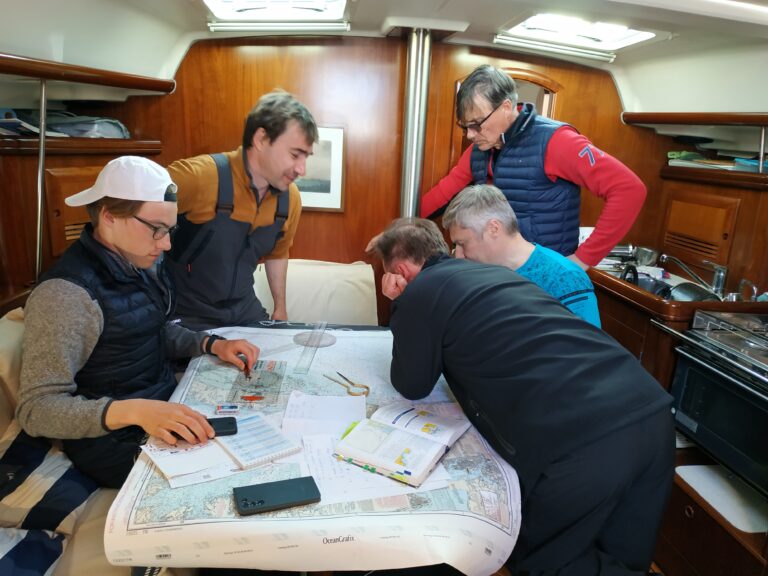
Montenegro - kotor
16-27 april 2024, kotor – herceg novi – budva – bar – portonovi – glavati – kotor.
Price – €980 Euro
Captain-instructor,
berth in DBL cabin, bed linen,
all necessary manuals.
€ 100 – fuel, final cleaning, yacht insurance,
marina fees,
after successful theory and practice exam – certificate Yachtmaster Coastal IYT – € 150
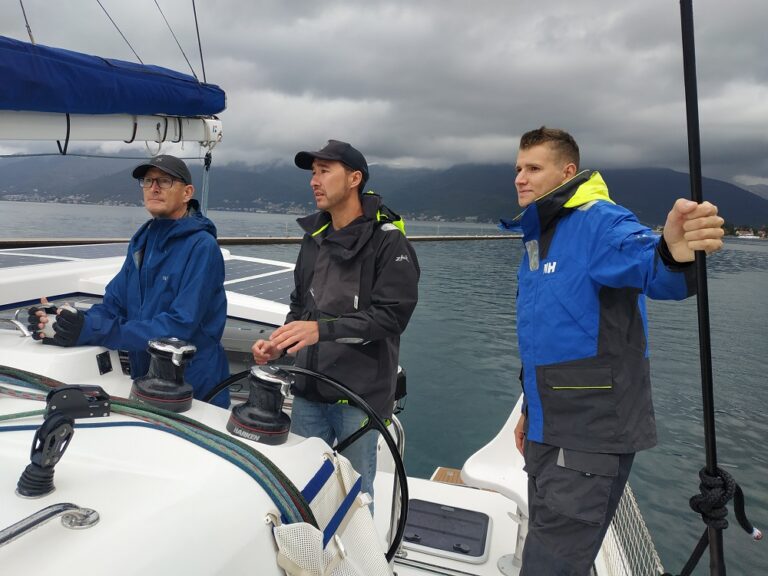
NETherlands - Lemmer
19-26 july 2024, lemmer – urk – enkhuizen – medemblick – harlingen – hindeloppen – lemmer.
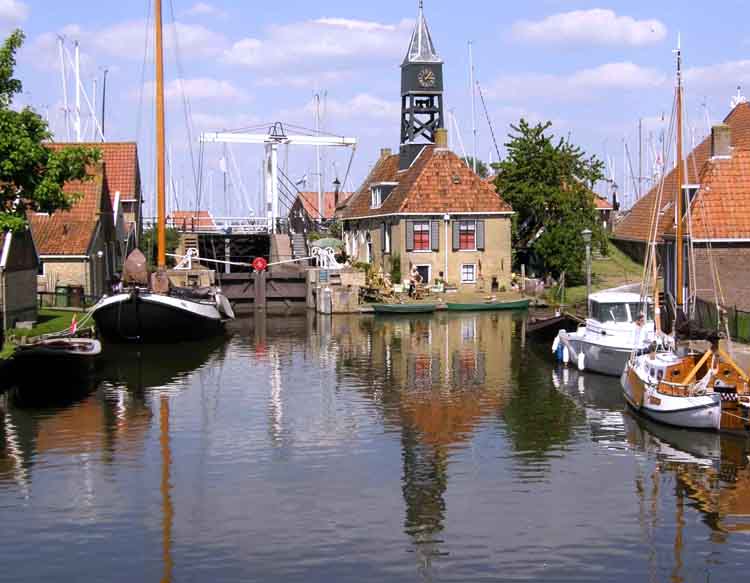
Atlantic France - La Trinite
07-14 september 2024, la trinite – quiberon – belle illes – concarneau – groua – port luis – la trinite.
Price – €890
Paid additionally: Meals on the yacht, including meals for the captain-instructor, m arina fees, Fuel (all about 250€ per person per week)
- Certificat Yachtmaster Coastal IYT – €150
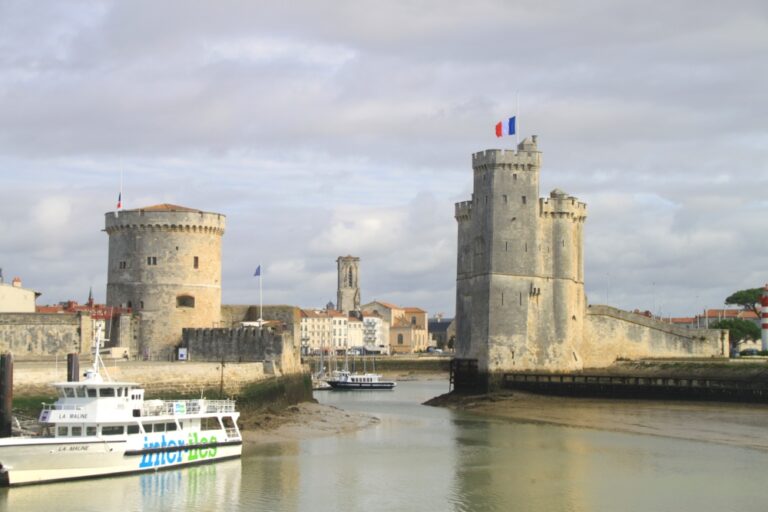
We know everything about sailing and yachting, or almost everything, and are going to share the accumulated information with you. We hope that you will appreciate our efforts for dignity, and training in the "Yacht-Challenge" will bring you joy and 100% result. Support for graduates after graduation!
Yachtmaster Coastal / Offshore Theory
The Royal Yachting Association Yachtmaster certificate has become the industry standard qualification after the entry-level stage. It is the first formal training in navigation and seamanship that deckhands receive on their path to higher MCA issued certificates and it is a vital part of their maritime education. This course equips you to navigate safely on coastal and offshore passages. It will take your theory knowledge to the standard required for the Yachtmaster Coastal and Yachtmaster Offshore practical exams, concentrating on advanced navigation and meteorology skills.
Instructor student ratio 1:8
You will learn:
• position fixing
• course shaping and plotting
• tidal knowledge
• use of almanacs and admiralty publications
• electronic position finding equipment
• taking and interpreting forecasts
• plotting weather systems
• weather predictions using a barometer and by observation
• collision regulations
• customs and excise regulations for cruising abroad.
For MCA OOW, Chief Mate and Master Certificates it is a requirement that this theory course is successfully completed as part of the training. This course is fully redeemable with your ONE Account vouchers (excluding exam fee).
We provide this yacht training course in Antibes.
3 exam papers over the duration of the course
GMDSS SRC Marine Radio (VHF) , Elementary First Aid (STCW Code A-VI/1-3)
- Navigational knowledge of Day Skipper standard
- Professional Practices and Responsibilities (PPR) Online test (for commercial endorsement)
- 2500 sea miles (at least half in tidal miles and half in vessels between 7mLWL-24m LOA sub 80GT and all below 500GT), 50 days at sea, 5 passages over 60nm in vessels between 7m LWL-24m LOA and sub 80GT - including: 2 overnight passages and 2 as skipper
- Personal Survival Techniques (for commercial endorsement)
- I have a sufficient level of spoken and written English to understand the course content and to pass any verbal or written assessments.
Take advantage of the search to browse through the World Heritage Centre information.
Share on social media
Unesco social media, kremlin and red square, moscow.
- Description
Inextricably linked to all the most important historical and political events in Russia since the 13th century, the Kremlin (built between the 14th and 17th centuries by outstanding Russian and foreign architects) was the residence of the Great Prince and also a religious centre. At the foot of its ramparts, on Red Square, St Basil's Basilica is one of the most beautiful Russian Orthodox monuments.
Description is available under license CC-BY-SA IGO 3.0
Le Kremlin et la place Rouge, Moscou
Indissolublement lié à tous les événements historiques et politiques les plus importants survenus en Russie depuis le XIII e siècle, le Kremlin a été construit entre le XIV e et le XVII e siècle par des architectes russes et étrangers exceptionnels. C'était la résidence du grand-prince ainsi qu'un centre religieux. Au pied de ses remparts, sur la place Rouge, s'élève la basilique Basile-le-Bienheureux, l'un des plus beaux monuments de l'art orthodoxe.
الكرملين والساحة الحمراء، موسكو
يرتبط الكرملين ارتباطاً وثيقاً بجميع الأحداث التاريخيّة والسياسيّة المهمّة التي توالت على روسيا منذ القرن الثالث عشر ولقد جرى تشييده بين القرنين الرابع والسابع عشر على يد مهندسين روس وأجانب استثنائيين. وكان الكرملين مقرّ الأمير الكبير كما كان مركزاً دينيّاً. عند أسفل أسواره في الساحة الحمراء شيدت بازيليك القديس بازيل وهي من أروع تحف الفنّ الأرثوذكسي.
source: UNESCO/CPE Description is available under license CC-BY-SA IGO 3.0
莫斯科克里姆林宫和红场
由俄罗斯和外国建筑家于14世纪至17世纪共同修建的克里姆林宫,作为沙皇的住宅和宗教中心,与13世纪以来俄罗斯所有最重要的历史事件和政治事件密不可分。在红场上防御城墙的脚下坐落的圣瓦西里教堂是俄罗斯传统艺术最漂亮的代表作之一。
El kremlin y la Plaza Roja de Moscú
Indisolublemente vinculado a los más trascendentales acontecimientos históricos y políticos de Rusia desde el siglo XIII, el kremlin de Moscú fue construido entre los siglos XIV y XVII por toda una serie de excelentes arquitectos rusos y extranjeros. Además de ser la residencia del Gran Príncipe, fue un importante centro religioso. Al pie de sus murallas, en la Plaza Roja, se alza la basílica de San Basilio el Bienaventurado, uno de los más hermosos monumentos de arte ortodoxo.
モスクワのクレムリンと赤の広場
source: NFUAJ
Kremlin en Rode Plein, Moskou
Het Kremlin is onlosmakelijk verbonden met alle belangrijke historische en politieke gebeurtenissen in Rusland sinds de 13e eeuw. Het werd door de Grote Prins Yuri van Kiev gesticht als residentie en religieus centrum. De bouw vond plaats tussen de 14e en 17e eeuw en het ontwerp was in handen van uitstekende Russische en buitenlandse architecten. Binnen de muren van het Kremlin vindt men een reeks meesterwerken qua architectuur, maar ook beeldende kunst en religieuze monumenten van uitzonderlijke schoonheid. Aan de voet van de stadsmuren, op het Rode Plein, bevindt zich een van de mooiste Russisch-orthodoxe monumenten, de Pokrovkathedraal ook wel Basiliuskathedraal genoemd.
Source: unesco.nl

Outstanding Universal Value
Brief synthesis
At the geographic and historic centre of Moscow, the Moscow Kremlin is the oldest part of the city. First mentioned in the Hypatian Chronicle in 1147 as a fortification erected on the left bank of the Moskva river by Yuri Dolgoruki, Prince of Suzdal, the Kremlin developed and grew with settlements and suburbs which were further surrounded by new fortifications - Kitaigorodsky Wall, Bely Gorod, Zemlyanoy Gorod and others. This determined a radial and circular plan of the centre of Moscow typical of many other Old Russian cities.
In 13th century the Kremlin was the official residence of supreme power - the center of temporal and spiritual life of the state. The Kremlin of the late 15th – early 16th century is one of the major fortifications of Europe (the stone walls and towers of present day were erected in 1485–1516). It contains an ensemble of monuments of outstanding quality.
The most significant churches of the Moscow Kremlin are situated on the Cathedral Square; they are the Cathedral of the Dormition, Church of the Archangel, Church of the Annunciation and the bell tower of Ivan Veliki. Almost all of them were designed by invited Italian architects which is clearly seen in their architectural style. The five-domed Assumption Cathedral (1475–1479) was built by an Italian architect Aristotele Fiorvanti. Its interior is decorated with frescos and a five-tier iconostasis (15th–17th century). The cathedral became the major Russian Orthodox church; a wedding and coronation place for great princes, tsars and emperors as well as the shrine for metropolitans and patriarchs.
In the same square another Italian architect, Alevisio Novi, erected the five-domed Church of the Archangel in 1505-1508. From the 17th to 19th century, its interior was decorated by wonderful frescos and an iconostasis. In this church many great princes and tsars of Moscow are buried. Among them are Ivan I Kalita, Dmitri Donskoi, Ivan III, Ivan IV the Terrible, Mikhail Fedorovich and Alexei Mikhailovich Romanovs.
The Cathedral of the Dormition was built by Pskov architects in 1484–1489. Inside the cathedral some mural paintings of 16th–19th century have been preserved and the icons of Andrei Rublev and Theophanes the Greek are part of the iconostasis.
In 1505-1508 the bell tower of Ivan Veliki was built. Being 82 metres high it was the highest building in Russia which became the focal point of the Kremlin ensemble.
Among the oldest civil buildings of the Moscow Kremlin, the Palace of the Facets (1487–1491) is the most remarkable. Italian architects Marco Fryazin and Pietro Antonio Solario built it as a great hall for holding state ceremonies, celebrations and for receiving foreign ambassadors. The most noteworthy civil construction of the 17th century built by Russian masters is the Teremnoi Palace.
From the early 18th century, when the capital of Russia moved to St. Petersburg, the Kremlin mainly played a ceremonial role with religious functions. By the end of the century the architectural complex of the Kremlin expanded with the Arsenal reconstructed after the Fire of 1797 by Matvei Kazakov. The Senate was built in 1776–1787 according to the plans of the same architect as the home of the highest agency of State power of the Russian Empire - the Ruling Senate. Today it is the residence of the President of Russia.
From 1839 to 1849 a Russian architect K.A. Thon erected the Great Kremlin Palace as a residence of the imperial family which combined ancient Kremlin buildings such as the Palace of the Facets, the Tsarina’s Golden Chamber, Master Chambers, the Teremnoi Palace and the Teremnoi churches. In the Armory Chamber built by K.A. Thon within the complex of the Great Kremlin Palace, there is a 16th century museum officially established by the order of Alexander I in 1806.
Red Square, closely associated with the Kremlin, lies beneath its east wall. At its south end is the famous Pokrovski Cathedral (Cathedral of St Basil the Blessed), one of the most beautiful monuments of Old Russian church architecture, erected in 1555–1560 to commemorate the victory of Ivan the Terrible over the Kazan Khanate. In the 17th century the cathedral gained its up-to-date appearance thanks to the decorative finishing of the domes and painting both inside and outside the cathedral. The construction of Red Square was finished by the late 19th century together with the erection of the Imperial Historic Museum (today the State Historical Museum), the Upper Trading Rows (GUM) and the Middle Trading Rows. In 1929, , Lenin’s Mausoleum, designed by A.V. Shchusev and an outstanding example of the Soviet monumental architecture, was finished.
Criterion (i) : The Kremlin contains within its walls a unique series of masterpieces of architecture and the plastic arts. There are religious monuments of exceptional beauty such as the Church of the Annunciation, the Cathedral of the Dormition, the Church of the Archangel and the bell tower of Ivan Veliki; there are palaces such as the Great Palace of the Kremlin, which comprises within its walls the Church of the Nativity of the Virgin and the Teremnoi Palace. On Red Square is Saint Basil the Blessed, still a major edifice of Russian Orthodox art.
Criterion (ii) : Throughout its history, Russian architecture has clearly been affected many times by influences emanating from the Kremlin. A particular example was the Italian Renaissance. The influence of the style was clearly felt when Rudolfo Aristotele Fioravanti built the Cathedral of the Dormition (1475-79) and grew stronger with the construction of the Granovitaya Palace (Hall of the Facets, 1487-91) by Marco Fryazin and Pietro Antonio Solario. Italian Renaissance also influenced the towers of the fortified enceinte, built during the same period by Solario, using principles established by Milanese engineers (the Nikolskaya and the Spasskaya Towers both date from 1491). The Renaissance expression was even more present in the classic capitals and shells of the Church of the Archangel, reconstructed from 1505 to 1509 by Alevisio Novi.
Criterion (iv) : With its triangular enceinte pierced by four gates and reinforced with 20 towers, the Moscow Kremlin preserves the memory of the wooden fortifications erected by Yuri Dolgoruki around 1156 on the hill at the confluence of the Moskova and Neglinnaya rivers (the Alexander Garden now covers the latter). By its layout and its history of transformations (in the 14th century Dimitri Donskoi had an enceinte of logs built, then the first stone wall), the Moscow Kremlin is the prototype of a Kremlin - the citadel at the centre of Old Russian towns such as Pskov, Tula, Kazan or Smolensk.
Criterion (vi) : From the 13th century to the founding of St Petersburg, the Moscow Kremlin was directly and tangibly associated with every major event in Russian history. A 200-year period of obscurity ended in 1918 when it became the seat of government again. The Mausoleum of Lenin on Red Square is the Soviet Union’s prime example of symbolic monumental architecture. To proclaim the universal significance of the Russian revolution, the funerary urns of heroes of the revolution were incorporated into the Kremlin’s walls between the Nikolskaya and Spasskaya towers. The site thus combines in an exceptional manner the preserved vestiges of bygone days with present-day signs of one of the greatest events in modern history.
From the date of including the Moscow Kremlin and Red Square on the World Heritage List all the components representing the Outstanding Universal Value of the property are within its boundaries. The territory and the integrity of the World Heritage property have also remained unchanged. Within its boundaries the property still comprises all the elements that it contained at the date of nomination. The biggest threat, however, is unregulated commercial development of the adjacent areas.
Authenticity
The history of the Moscow Kremlin and Red Square is reflected in the archival documents of 12th–19th century, for example in medieval chronicles, cadastral surveys, estimated construction books, painted lists, inventories, foreign notes and in graphic matters such as manuscripts, chronicles, plans, drafts, engravings, lithographs, sketches of foreign travelers, paintings and photographs. These documents are exceptionally valuable information sources. Comparison of the data received from archival documents and those obtained in the process of field study gives the idea of authenticity of the property and its different elements. This comparison also serves as the basis for project development and for the choice of the appropriate methods of restoration that may preserve the monuments’ authenticity.
On the border of the ensemble a number of monuments destroyed in the 1930s were reconstructed according to measured plans.
Protection and management requirements
The statutory and institutional framework of an effective protection, management and improvement of the World Heritage property “Kremlin and Red Square, Moscow” has been established by laws and regulations of the Russian Federation and the city of Moscow.
According to the decree of the President of RSFSR of 18 December 1991 № 294, the Moscow Kremlin was included among especially protected cultural properties of nations of Russia - the highest conservation status for cultural and historical monuments in Russian legislation.
“Kremlin and Red Square, Moscow” is a Cultural Heritage Site of federal importance. State protection and management of federal sites is provided by Federal Law of 25.06.2002 № 73-FZ “On cultural heritage sites (historical and cultural monuments) of nations of the Russian Federation”. The federal executive body responsible for protection of the cultural property is the Department for Control, Supervision and Licensing in the Cultural Heritage Sphere of the Ministry of Culture of the Russian Federation.It is in charge of all methodological and control functions concerning restoration, usage and support of cultural heritage sites and the territories connected.
The World Heritage property is situated in the urban environment of Moscow. The city policy regarding cultural heritage protection and town-planning regulation is the responsibility of Moscow City Government, represented by the Department of Cultural Heritage, the Department of Urban Development and the Committee for Urban Development and Architecture of Moscow. In 1997 the boundaries of the protective (buffer) zone were approved in order to preserve the property, and to maintain and restore the historical architectural environment as well as the integral visual perception of the property.. There is a need to ensure the creation of an appropriate buffer zone and to develop close liaison between all stakeholders, including the Moscow City authorities, to ensure that constructions around the property do not impact adversely on its Outstanding Universal Value.
The World Heritage property is used by the following organizations: FGBUK (Federal Government Budgetary Institution of Culture), the State Historical and Cultural Museum-preserve “The Moscow Kremlin”, the Administrative Department of the President of the Russian Federation, the Federal Guard Service of the Russian Federation and OJSC “GUM Department Store”.
- Official site of 'The Moscow Kremlin' State Historical and Cultural Museum and Heritage Site
- Moscow Kremlin Museums Telegram Group (in Russian only)
- Moscow Kremlin Museums VKontakte Page (in Russian only)
- Moscow Kremlin Museums Dzen Page (in Russian only)
- State Historical Museum VKontakte Group (in Russian only)
- Msk Guide Page (in Russian only)
- Official site of the State Department Store
- State Historical Museum (in Russian only)

State of Conservation (SOC)
Put-in tours
Original tour agency in moscow and st petersburg..
Onboard a Soviet van!
Welcome to Russia!
We are Sergey and Simon, a Russian and a Frenchman, both passionate about Moscow, Saint-Petersburg and classic cars. Together, we have created Put-in tours. Our goal is to help you experience Russian culture off the beaten path. Join us onboard our classic Soviet van and let’s get rolling!
In Moscow we offer you a city tour to discover most of the city in an original way as well as a night tour to admire the lights. Our pubcrawl is ideal to explore Moscow’s night-life and have fun. If you are craving to discover Russian culture, come impress your senses during our monastery diner or join our 100% Russian Banya Excursion . The latest will also bring you to Sergiyev Posad and it’s famous monastery!
For the most extreme travellers, our shooting tour will deliver your daily dose of adrenaline whereas our tank excursion will let you ride a real tank and shoot a bazooka.
We also offer help to receive your visa , safe and multilingual airport transfers , as well as organisation services for team-building events or bachelor parties .
All our excursions (but the monastery diner) happen onboard our Soviet military vans and can be covered by our professionnal photographer or videographer.
In Saint Petersburg
We welcome you in Saint Petersburg onboard our Soviet van to discover the imperial city with our city tour and night tour .
Continue your discovery in style! The adrenaline lovers will like our shooting tour which brings 3 Russian weapons to the tip of your trigger finger.
Follow us on Social Media...
Our partners
© Copyright 2021 - Put-in tours Designed by SD Marketing & Design
At Put-in tours, we put you in our classic Soviet vans to go explore Moscow, Saint Petersburg and Russian culture off the beaten path. Discover our Moscow city guided tour, visit Moscow by night, join our banya & Sergiyev Posad excursion, visit and dine in one of Moscow's oldest monastery or even Luzhniki stadium, before you party on our famous pubcrawl! Original and atypical tours : Shoot AK47 and a bazooka after riding on a tank with our tank & bazooka excursion ! Extreme tours: Fly a fighter jet in Moscow onboard a L-29 or L-39 aircraft!
© Copyright 2021 – Put-in tours
Design web: SD Marketing & Design
Home About us Videos Moscow Saint-Petersburg Contact Online booking Blog Disclaimer Privacy Policy
WhatsApp us

IMAGES
COMMENTS
RYA Yachtmaster Coastal Exam. The RYA Yachtmaster® Coastal has the knowledge needed to skipper a yacht on coastal cruises but does not necessarily have the experience needed to undertake longer passages. Full details of the exam syllabus and requirements are shown in the RYA Yachtmaster Scheme and Logbook (G158) available from the RYA webshop.
Yachtmaster Coastal Training. The IYT Worldwide Yachtmaster Coastal certificate is a recreational certificate of competency for command of sailing and/or power vessels up to 24 metres in length up to 60 nm offshore. It is a comprehensive live aboard course consisting of six days for sail or five days for power, which includes the practical on ...
The RYA Yachtmaster course is accredited by the RYA and MCA and recognized for service as Captain or Mate (OOW) up to 200gt up to 150 miles from a safe haven, at the Offshore level or up to 60 miles from safe haven at the Coastal level. The Yachtmaster CoC meets the STCW A-V1/1 and section A V1/1-4 when combined with Basic Training Courses.
The RYA Yachtmaster® Coastal Certificate of Competence is proof that you have the knowledge needed to skipper a yacht on any coastal cruise. The holder of a Yachtmaster Coastal qualification should be competent to skipper a yacht of up to 24 metres LOA (up to 200gt) in waters up to 20 miles from a safe haven. Don't treat the examination just ...
The gold standard. The RYA Yachtmaster® Certificate of Competence is often the ultimate aim of aspiring skippers. It is a well known, highly respected qualification worldwide, proving your experience and competence as a skipper. Unlike other qualifications in the cruising programme, there is no formal training course to become an RYA Yachtmaster.
The Sunsail Yachtmaster Coastal prep and exam course is a follow-on course from the theory and practical elements of the Coastal Skipper course. Upon achieving your RYA Yachtmaster Coastal certificate you will be recognised as an advanced, experienced sailor. Advanced skipper qualification. Internationally recognized. Fine tune sailing techniques.
The IYT Worldwide Yachtmaster Coastal certificate is a recreational certificate of competency for command of sailing and/or power vessels up to 24 metres in length up to 60 nm offshore. It is a comprehensive live aboard course consisting of six days for sail or five days for power, which includes the practical on water examination. The minimum ...
Recently, the old Coastal Skipper ticket has been superseded by the new 'Yachtmaster Coastal' certificate. The qualifying mileage for this MCA-recognised qualification is 800, with passage and night-hour requirements being relaxed in comparison with 'Yachtmaster Offshore', which keeps its 2,500-mile entry level.
The preparation course is run over 5 days and designed to assess your level of competency against the RYA Yachtmaster Coastal or RYA Yachtmaster Offshore exam syllabus found in the RYA Yachtmaster Scheme Syllabus and Logbook (G158/15) and is intended to fine tune your existing skills and polish any areas of weakness prior to the exam.
Fee's for Yachtmaster Certificate preparation. Voyage fee is for the full 5 days of instruction (or 8 days if you go on to do the exam) Examination fee payable to the examiner -RYA Yachtmaster offshore Exam is £215 and Yachtmaster Coastal is roughly £185 per person (2019). Yachtmaster Coastal Pre Exam Requirements.
Intensive preparation for RYA Yachtmaster Coastal and Offshore. The Boat School 5-day Yactmaster Preparation course (Sail) is an intensive course to hone your practical skills before you take the the RYA Yachtmaster Coastal or Offshore exam. Depending on your skill level and experience, you can elect to take the Yachtmaster exam at the Coastal ...
The RYA Yachtmaster online theory course takes your theory knowledge to the standard required for the Yachtmaster Coastal and Yachtmaster Offshore practical exams.. This course advances your skills as a skipper of a yacht or motor boat, with an emphasis on navigation and passage planning for more complex coastal or offshore passages by day and night
Gain more experience: After completing the Coastal Skipper course, you will need to gain more experience before you can start working towards your Yacht Master qualification.This usually involves logging more sea miles and completing more helm time. Complete the Yacht Master theory course: This course covers advanced navigation, meteorology, collision regulations, and safety at sea.
Yachtmaster Coastal Certificate of Competence (power or sail) This certificate follows the successful completion of a practical exam which is discussed in this article. The exam can be taken on board a sailing yacht or motor boat, (and the qualification is endorsed for the relative type of craft). The Yachtmaster Coastal CoC certifies skippers ...
Prerequisites to sit for the Yachtmaster Coastal Exam are: (completed in the last 10 years) • 800 Nautical Miles of which a minimum of 400 in tidal waters. • 2 days as skipper. • 12 night hours. • 30 days at sea. • SRC/VHF Radio Certification. • First Aid Certification within the last two years. (the mileage and seatime requirement ...
The Yachtmaster Coastal IYT is a recreational certificate of competency for command of vessels up to 24 m in length up to 60 nm offshore in moderate wind and sea conditions. The Candidate for Yachtmaster Coastal IYT certificate should have 800 nautical miles, 25 days on board at sea (2 days at least as captain), 12 hours on watch at nighty.
The Yachtmaster Online Theory course is the third level of online RYA training available, covering the syllabus for Yachtmaster Coastal and Yachtmaster Offshore theory in a single course. This is advanced training for more experienced sailors, building on the Day Skipper practical and theory courses and equipping you to navigate safely on ...
The Yachtmaster Offshore carries MCA recognition as a certificate of competency in its own right under the "Small Commercial Vessel' and "Large Yacht" codes. Holders of the certificate can command a charter yacht up to 24m load-line length or 200 GT up to 150 nm from a safe haven. This preparative session is not for beginners. You will learn: Practical boat handling and navigation in our 15 ...
The Royal Yachting Association Yachtmaster certificate has become the industry standard qualification after the entry-level stage. It is the first formal training in navigation and seamanship that deckhands receive on their path to higher MCA issued certificates and it is a vital part of their maritime education. This course equips you to navigate safely on coastal and offshore passages.
Moskau Hauptstadt Russlands 12 Millionen Einwohner. Stadtrundfahrt - Kreml - Roter Platz - GUM Kaufhaus - Metro größte U Bahn der Welt
Le Kremlin et la place Rouge, Moscou. Indissolublement lié à tous les événements historiques et politiques les plus importants survenus en Russie depuis le XIII e siècle, le Kremlin a été construit entre le XIV e et le XVII e siècle par des architectes russes et étrangers exceptionnels. C'était la résidence du grand-prince ainsi qu'un centre religieux.
Here's an F2 onboard lap at the Autodrom Moscow in Moscow, Russia. This hotlap is driven in Assetto Corsa with Robert Shwartzman in the F2 2020 car, using th...
Welcome to Russia! We are Sergey and Simon, a Russian and a Frenchman, both passionate about Moscow, Saint-Petersburg and classic cars. Together, we have created Put-in tours. Our goal is to help you experience Russian culture off the beaten path. Join us onboard our classic Soviet van and let's get rolling!